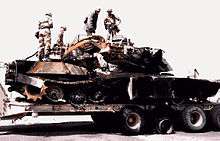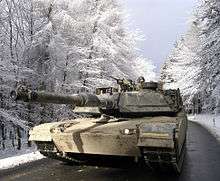M1 Abrams
The M1 Abrams is a third-generation American main battle tank designed by Chrysler Defense (now General Dynamics Land Systems).[9] Conceived for modern armored ground warfare and now one of the heaviest tanks in service at nearly 68 short tons (almost 62 metric tons), it introduced several innovative features, including a multifuel turbine engine, sophisticated Chobham composite armor, a computer fire control system, separate ammunition storage in a blow-out compartment, and NBC protection for crew safety. Initial models of the M1 were armed with a licensed-produced 105 mm Royal Ordnance L7 gun, while later variants feature a licensed Rheinmetall 120 mm L/44.
The M1 Abrams was developed from the failure of the MBT-70 project to replace the obsolescent M60 Patton. There are three main operational Abrams versions, the M1, M1A1, and M1A2, with each new iteration seeing improvements in armament, protection, and electronics. Efforts to develop an M1A3 version were first publicly disclosed in 2009.[10] Extensive improvements have been implemented to the latest M1A2C and D (formerly designated M1A2 System Enhancement Package version 3 or SEPv3 and M1A2 SEPv4, respectively) versions such as improved composite armor, better optics, digital systems and ammunition.[11] The Abrams was due to be replaced by the Future Combat Systems XM1202 but due to its cancellation, the U.S. military has opted to continue maintaining and operating the M1 series for the foreseeable future by upgrading with improved optics, armor and firepower.
The M1 Abrams entered service in 1980 and currently serves as the main battle tank of the United States Army and Marine Corps. The export version is used by the armies of Egypt, Kuwait, Saudi Arabia, Australia, and Iraq. The Abrams was first used in combat in the Persian Gulf War and has seen combat in both the War in Afghanistan and Iraq War under U.S. service, while Iraqi Abrams tanks have seen action in the war against ISIL and have seen use by Saudi Arabia during the Yemeni Civil War.
History
Previous developments
Through the 1960s the US Army and German Army had collaborated on a single design that would replace both the M60 Patton and the Leopard 1. The overall goal was to have a single new design with improved firepower to handle new Soviet tanks like the T-62, while providing improved protection against the T-62's new 115 mm smoothbore gun and especially high explosive anti-tank (HEAT) rounds.[12]
The resulting design, the MBT-70, incorporated new technologies across the board. A hydropneumatic suspension provided excellent cross-country ride quality and also allowed the entire tank to be raised or lowered by the driver, with the lowest position placing the top of the tank only 6 feet (1.8 m) off the ground. New 1,500 hp-class engines powered the designs which could both reach 43 miles per hour (69 km/h), 50% faster than the T-62. Finally, two new guns were introduced, a US 152 mm design whose primary long-range weapon was the Shillelagh missile, while the Germans introduced a new 120 mm smoothbore design.[12]
While the design was highly capable, its weight continued to grow, as did its budget. By 1969, the unit cost stood at five times the original estimates.[12] In August 1969 the Senate halted funding of the program until the Government Accounting Office could undertake an audit of the program.[13]
Starting afresh
As a result of the problems with the MBT-70, the U.S. Army introduced the XM803, using some technologies from the MBT-70 but removing some of the more troublesome features. This succeeded only in producing an expensive system with capabilities similar to the M60.[14] Congress canceled the MBT-70 in November and XM803 December 1971, and redistributed the funds to the XM1 Abrams named after General Creighton Abrams.
The Tank-automotive and Armaments Command (TACOM) began examining specific goals. After several rounds of input, the decision was made to offer maximum armor to defeat the "heavy threat". Heavy in this context considered the 115 mm gun of the T-62 using projected improvements of their APFSDS ammunition through the 1980s, or the new 125 mm gun of the T-64 and T-72 firing high-explosive anti-tank (HEAT) rounds.[15]
To this end, a new design basis emerged in February 1973, LK 10372. It had to defeat any hit from a Soviet gun within 800 meters and 30 degrees to either side. The tank would be armed with the 105 mm M68 gun, a licensed version of the Royal Ordnance L7, along with a coaxial 20 mm version of the Bushmaster.[4]
Examining the experiences of the Yom Kippur War that year, a number of design changes were made. The newly-created "Burlington" armor from the British Army's labs was incorporated to improve protection, especially against HEAT, and to incorporate the new armor package, the original goal of keeping weight under 50 short tons (45 t) was abandoned. The Bushmaster was seen as superfluous and was replaced with a M240 machine gun, the US version of the FN MAG. As TACOM continued to improve the detailed design, initial samples of the armor system were sent to the Ballistics Research Laboratory for testing.[15]
At the time, the US military's procurement system was beset with problems being caused by the desire to have the best possible design. This often resulted in the programs being canceled due to cost overruns, leaving the forces with outdated systems, as was the case with the MBT-70. There was a strong movement within the Army to get a new design within budget to prevent the MBT-70 experience from repeating itself. For the new design, the Army stated the unit cost was to be no more than $507,000 in 1972 dollars (equivalent to $3,098,871 in 2019) and gave the contract out to the industry. Chrysler and GM entered bids.[16]
More changes
Through the period while the initial prototypes were being built, a debate broke out between Germany and US about the use of the 105 mm gun. The Army was planning on introducing several new types of ammunition for the 105 that would greatly improve its performance, notably, the XM-774 using depleted uranium. These rounds would give it the performance needed to defeat any Soviet tank with ease. There was some concern that depleted uranium would not be allowed in Germany, perhaps just in peacetime, so improvements to the tungsten cored M735 were also considered.
Through this same period, there was an ongoing effort to improve NATO logistics by standardizing ammunition to the maximum possible degree. The Germans were moving ahead with their 120 mm gun on the Leopard 2K, and noted that the British had also introduced a 120 mm gun of their own in keeping with their long-range combat doctrine. Although initially skeptical of the need for a 120 mm gun, at some point the issue was raised that the Soviets might introduce a tank with composite armor. In this case, the 120 would give them the performance needed to defeat such a development even without depleted uranium.
By 1977 the decision had been made to eventually move the new tank to a 120 mm gun. After head-to-head testing between the Royal Ordnance L11A5 and the Rheinmetall Rh-120, the latter was chosen. The turret designs of the two prototypes were modified to allow either gun to be fitted. Although the L11/M256 120mm gun was chosen to be the main weapon of the M1 Abrams in 1979, the improved ammunition for the gun still was not fully developed, thus delaying its fielding until 1984.[17] The early production versions of the M1 Abrams (M1 & IPM1) were armed with the M68A1[18] for two reasons. First was due to the large number of M60 Patton tanks with the M68E1 gun still in widespread US service in the 1980s and a large on-hand stockpile of 105mm munitions. Fitting the M1 with the M68A1 gun was viewed as an economical and practical solution that allowed for commonality in ammunition among the two types of tanks.[19] Secondly was that the M68A1 could employ the newly developed M900 APFSDS[20] depleted uranium round that had improved penetration performance in comparison to the M774.[21]
Prototypes
Prototypes were delivered in 1976 by Chrysler Defense and General Motors (GM) armed with the license-built M68E1 version of the 105 mm Royal Ordnance L7. They entered head-to-head testing at Aberdeen Proving Ground, along with a Leopard 2 "2K" prototype for comparison. The testing showed that the GM design was generally superior, offering better armor protection, and better fire control and turret stabilization systems.[16] These early preproduction prototypes were provisionally armed with the M68E1 105mm main gun while a preferred 120mm gun and its ammunition were in their design and component development phase. These prototypes used a combination mount that allowed for the evaluation of both 105mm and 120mm guns.[22]
In January 1978, a program was initiated[23] to develop an enhanced version of the 105mm gun, the M68A1[24] as a possible alternate weapon for the M1 Abrams. The new XM24/L55 gun barrel was 18 inches (45.72cm) longer in comparison to the XM24/L52 barrel used on the M60 tanks.[25] It has a higher chamber pressure,[26] reinforced breach and a higher muzzle velocity.[27][28]
During testing, the power packs of both designs proved to have issues. The Chrysler design used a gas turbine engine from Lycoming Engines, the AGT1500, which had extensive heat recovery systems in an attempt to improve its fuel economy to something similar to a traditional internal combustion engine. This proved not to be the case; the engine consumed much more fuel than expected. The GM design used a new variable-compression Diesel design which proved to be problematic.[16] There is no evidence that GM considered using the MTU engine of the MBT-70, which outperformed both and had been chosen for the Leopard 2K.
By the spring of 1977, the decision to choose the GM design was largely complete. In addition to offering better overall performance, there were concerns about Chrysler's engine both from a reliability and fuel consumption standpoint. The GM program was also slightly cheaper overall at $208 million compared to $221 million for Chrysler. In July 1977, Lt. Colonel George Mohrmann prepared a stack of letters informing Congress of the decision to move ahead with the GM design. All that was required was the final sign-off by the Secretary of Defense, Donald Rumsfeld.[16]
Chrysler is chosen
On 20 July, United States Secretary of the Army Martin Hoffman and a group of generals visited Deputy Defense Secretary Bill Clements and Director of Defense Research and Engineering Malcolm Currie on their decision. They were surprised when Clements and Currie criticized their decision and demanded the turbine be selected. Donald Rumsfeld heard arguments from both in the afternoon and asked for twenty-four hours to review the issues. The Army team spent the night writing briefs and presented them to Rumsfeld the next morning, who then announced a four-month delay.[16]
Within days, GM was asked to present a new design with a turbine engine. According to Assistant Secretary for Research and Development Ed Miller, "It became increasingly clear that the only solution which would be acceptable to Clements and Currie was the turbine... It was a political decision that was reached, and for all intents and purposes that decision gave the award to Chrysler since they were the only contractor with a gas turbine."[16] However, the Chrysler design had the advantage that the entire power pack had room to be replaced by any number of engine designs, including a Diesel if needed.[15]
The turbine engine does not appear to be the only reason for this decision. Chrysler was the only company that appeared to be seriously interested in tank development; the M60 had been lucrative for the company and relied on that program for much of its profit. In contrast, GM made only about 1% of its income from military sales, compared to 5% for Chrysler, and only submitted their bid after a "special plea" from the Pentagon.[16]
On 12 November 1976, the Defense Department awarded a $20 billion development contract to Chrysler.[16]
Production starts
Low initial rate production (LIRP) of the vehicle was approved on 7 May 1979.[4] In February 1982, General Dynamics Land Systems Division (GDLS) purchased Chrysler Defense, after Chrysler built over 1,000 M1s.[29] The M1 Abrams was the first vehicle to adopt Chobham armor.
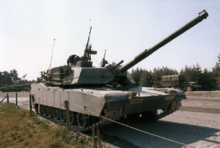
A total of 3,273 M1 Abrams tanks were produced during 1979–1985 and first entered U.S. Army service in 1980. Production at the government-owned, GDLS-operated Lima Army Tank Plant in Lima, Ohio, was joined by vehicles built at the Detroit Arsenal Tank Plant in Warren, Michigan from 1982 to 1996.[1] The U.S. Army Laboratory Command (LABCOM), under the supervision of the United States Army Research Laboratory (ARL), was also heavily involved with designing the tank with M1A1 armor resistant shells, M829A2 armor-penetrating rounds, and improved weapon range.[30] The M1 was armed with the license-built M68A1 version of the 105 mm Royal Ordnance L7 gun. The tank featured the first of its kind Chobham armor. The M1 Abrams was the first to use this advanced armor. It consisted of an arrangement of metal plates, ceramic blocks and open space.[31] An improved model called the M1IP was produced briefly in 1984 and contained small upgrades. The M1IP models were used in the Canadian Army Trophy NATO tank gunnery competition in 1985 and 1987.

About 5,000 M1A1 Abrams tanks were produced from 1986–92 and featured the M256 120 mm (4.7 in) smoothbore cannon developed by Rheinmetall AG of Germany for the Leopard 2, improved armor, consisting of depleted uranium and other classified materials, and a CBRN protection system. Production of M1 and M1A1 tanks totaled some 9,000 tanks at a cost of approximately $4.3 million per unit.[32] By 1999, costs for the tank were upwards of US$5 million a vehicle.[2]
In 1990, Project on Government Oversight in a report criticized the M1's high costs and low fuel efficiency in comparison with other tanks of similar power and effectiveness such as the Leopard 2. The report was based on data from U.S. Army sources and the Congressional record.[33]
As the Abrams entered service in the 1980s, they operated alongside M60A3 within the U.S. military, and with other NATO tanks in various Cold War exercises which usually took place in Western Europe, especially West Germany. The exercises were aimed at countering Soviet forces. However, by January 1991, the Berlin Wall had fallen and the Abrams was deployed in the Middle East.
Adaptations before the Persian Gulf War (Operations Desert Shield and Desert Storm) gave the vehicle better firepower and NBC (Nuclear, Biological and Chemical) protection.
Gulf War
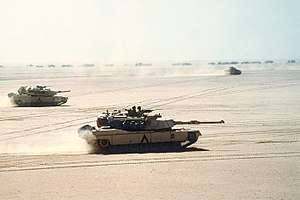
The Abrams remained untested in combat until the Persian Gulf War in 1991, during Operation Desert Storm. A total of 1,848 M1A1s were deployed to Saudi Arabia to participate in the liberation of Kuwait. The M1A1 was superior to Iraq's Soviet-era T-55 and T-62 tanks, as well as T-72 versions imported from the Soviet Union and Poland.[34] Polish officials state no license-produced T-72 (nicknamed Lion of Babylon) tanks were finished prior to the Iraqi Taji tank plant being destroyed in 1991.[34] The T-72s, like most Soviet export designs, lacked night vision systems and then-modern rangefinders, though they did have some night-fighting tanks with older active infrared systems or floodlights. A total of 23 M1A1s were damaged or destroyed during the war. Of the nine Abrams tanks destroyed, seven were destroyed by friendly fire, and two were purposely destroyed to prevent capture after being damaged.[35] Some others took minor combat damage, with little effect on their operational readiness. Very few M1 tanks were hit by enemy fire and none were destroyed as a direct result of enemy fire, none of which resulted in any fatalities.[36]
The M1A1 could kill other tanks at ranges in excess of 2,500 metres (8,200 ft). This range was crucial in combat against previous generation tanks of Soviet design in Desert Storm, as the effective range of the main gun in the Soviet/Iraqi tanks was less than 2,000 metres (6,600 ft). This meant Abrams tanks could hit Iraqi tanks before the enemy got in range—a decisive advantage in this kind of combat. In friendly fire incidents, the front armor and fore side turret armor survived direct armor-piercing fin-stabilized discarding-sabot (APFSDS) hits from other M1A1s. This was not the case for the side armor of the hull and the rear armor of the turret, as both areas were penetrated on at least two occasions by unintentional strikes by depleted uranium ammunition during the Battle of Norfolk.[37]
During Operations Operation Desert Shield and Desert Storm some M1IP and M1A1s were modified locally in theater (in the war zone) by modification work orders (MWO) with additional rolled homogenous armor plating welded on the turret front. The M1 can be equipped with mine plow and mine roller attachments.
Lessons from the war improved the tank's weapons sights and fire control unit.
Upgrades
The M1A2 was a further improvement of the M1A1 with a commander's independent thermal viewer, weapon station, position navigation equipment, and a full set of controls and displays linked by a digital data bus. These upgrades also provided the M1A2 with an improved fire control system.[38] The M1A2 System Enhancement Package (SEP) added digital maps, Force XXI Battle Command Brigade and Below (FBCB2) Linux communications system capabilities for commanders, and an improved cooling system to compensate for heat generated by the additional computer systems. The M1A2 SEP also serves as the basis for the M104 Wolverine heavy assault bridge. The M1A2 SEPv2 (version 2) added Common Remotely Operated Weapon Station (CROWS or CROWS II) support, color displays, better interfaces, a new operating system, better front and side armor, and an upgraded transmission for better durability.[39] Further upgrades included depleted uranium armor for all variants, a system overhaul that returns all A1s to like-new condition (M1A1 AIM), a digital enhancement package for the A1 (M1A1D), and a commonality program to standardize parts between the U.S. Army and the Marine Corps (M1A1HC). The development for the improved M1A3 variant has been known since 2009.[40][10]
Iraq War
Further combat was seen during 2003 when U.S. forces invaded Iraq and deposed Ba'athist Iraqi leader Saddam Hussein in the Iraq War's Operation Iraqi Freedom. During the invasion, at least nine Abrams tanks were put out of action by fire from rocket propelled grenades.[41] By March 2005, approximately 80 Abrams tanks were forced out of action by enemy attacks;[42] 63 tanks were restored, while 17 were damaged beyond repair[43] with 3 of them at the beginning of 2003.[44] From August 2005 to April 2008, at least 20 tanks of this type were destroyed.[45]
One achievement of the M1A1s was the destruction of seven T-72s in a point-blank skirmish (less than 50 yards (46 m)) near Mahmoudiyah, about 18 miles (29 km) south of Baghdad, with no U.S. losses.[46] This was in the face of inadequately trained Iraqi tank crews, most of whom had not fired live ammunition in the previous year due to the sanctions then in operation and made no hits at point-blank range.[41] In addition to the Abrams's heavy armament, some crews were also issued M136 AT4 shoulder-fired anti-tank weapons under the assumption that they might have to engage heavy armor in tight urban areas where the main gun could not be brought to bear.
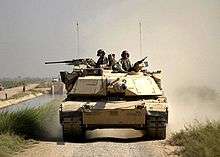
Following lessons learned in Desert Storm, the Abrams and many other U.S. combat vehicles used in the conflict were fitted with Combat Identification Panels to reduce friendly fire incidents. These were fitted on the sides and rear of the turret, with flat panels equipped with a four-cornered 'box' image on either side of the turret front. Some Abrams tanks were also fitted with a secondary storage bin on the back of the existing bustle rack on the rear of the turret (referred to as a bustle rack extension) to enable the crew to carry more supplies and personal belongings.
Several Abrams tanks that were irrecoverable due to loss of mobility or other circumstances were destroyed by friendly forces, usually by other Abrams tanks, to prevent their capture.[47] Some Abrams tanks were disabled by Iraqi infantrymen in ambushes during the invasion. Some troops employed short-range anti-tank rockets and fired at the tracks, rear and top. Other tanks were put out of action by engine fires when flammable fuel stored externally in turret racks was hit by small arms fire and spilled into the engine compartment.[48][49] By December 2006 more than 530 Abrams tanks had been shipped back to the U.S. for repair.[50]
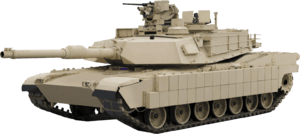
Vulnerabilities exposed during urban combat in the 2003 invasion of Iraq were addressed with the Tank Urban Survival Kit (TUSK) modifications, including armor upgrades and a gun shield, issued to some M1 Abrams tanks. It added protection in the rear and side of the tank to improve fighting ability in urban environments.[52]
In May 2008, it was reported that a U.S. M1 tank had also been damaged in Iraq by insurgent fire of a Soviet-made RPG-29 "Vampir", which uses a tandem-charge high explosive anti-tank warhead to penetrate explosive reactive armor (ERA) as well as composite armor behind it.[53] The U.S. considered the RPG-29 threat to U.S. armor high and refused to allow the newly formed Iraqi Army to buy it, fearing that it would fall into the insurgents' hands.[54]
Iraqi Army service
Between 2010 and 2012 the U.S. supplied 140 refurbished M1A1 Abrams tanks to Iraq. In mid-2014, they saw action when the Islamic State of Iraq and the Levant launched the June 2014 Northern Iraq offensive. During three months, about one-third of the Iraqi Army's M1 tanks had been damaged or destroyed by ISIL and some were captured by opposing forces. By December 2014, the Iraqi Army only had about 40 operational Abrams left. That month, the U.S. Department of State approved the sale of another 175 Abrams to Iraq.[55][56][57]
Iranian-backed Iraqi Shiite Kata'ib Hezbollah (Hezbollah Brigades) reported to operate M1 Abrams, and released publicity showing the tanks being transported by trucks to take part in the battle of Mosul. It is not known whether the tanks were captured from ISIS, seized from Iraq's military, or handed over.[58]
One Iraqi-operated Abrams has been nicknamed "The Beast" after it became the lone working tank when taking back the town of Hit in April 2016, destroying enemy fighting positions and IED emplacements.[59]
In October 2017, Abrams were used by the Iraqi security forces and the Popular Mobilization Forces (also called Al-Hashd al-Shaabi) in assaults against the Kurdistan Regional Government Peshmerga in the town of Altun Kupri (also called Prde). It was claimed by Kurdish commanders that at least one Abrams was destroyed by the Peshmerga.[60]
War in Afghanistan
Tanks may have limited utility in Afghanistan due to the mountainous terrain, although Canada and Denmark have deployed Leopard 1 and 2 MBTs that have been specially modified to operate in the relatively flat and arid conditions of southwestern Afghanistan. In late 2010, at the request of Regional Command Southwest, the U.S. Marine Corps deployed a small detachment of 14 M1A1 Abrams tanks from Delta Company, 1st Tank Battalion, 1st Marine Division (Forward),[61] to southern Afghanistan in support of operations in Helmand and Kandahar provinces.[62]
2015 Yemen Civil War
After the start of the Saudi Arabian intervention in Yemen during the 2015 Yemeni Civil War, Saudi Arabian M1A2 MBTs were deployed near the Saudi Arabian/Yemeni border.[63] In August 2016, the U.S. approved a deal to sell up to 153 more Abrams tanks to Saudi Arabia, including 20 "battle damage replacements", suggesting that some Saudi Arabian Abrams had been destroyed or severely damaged in combat in Yemen.[64][65][66]
Production
Production shutdown
The U.S. Army planned to end production at the Lima Army Tank Plant from 2013 to 2016 in an effort to save over $1 billion; it would be restarted in 2017 to upgrade existing tanks. General Dynamics Land Systems (GDLS), which operates the factory, opposed the move, arguing that suspension of operations would increase long-term costs and reduce flexibility.[67][68] Specifically, GDLS estimated that closing the plant would cost $380 million and restarting production would cost $1.3 billion.[69]
By August 2013, Congress had allocated $181 million for buying parts and upgrading Abrams systems to mitigate industrial base risks and sustain development and production capability. Congress and General Dynamics were criticized for redirecting money to keep production lines open and accused of "forcing the Army to buy tanks it didn't need." General Dynamics asserted that a four-year shutdown would cost $1.1–1.6 billion to reopen the line, depending on the length of the shutdown, whether machinery would be kept operating, and whether the plant's components would be completely removed. They contended that the move was to upgrade Army National Guard units to expand a "pure fleet" and maintain production of identified "irreplaceable" subcomponents; a prolonged shutdown could cause their makers to lose their ability to produce them and foreign tank sales were not guaranteed to keep production lines open. There is still risk of production gaps even with production extended through 2015; with funds awarded before recapitalization is needed, budgetary pressures may push planned new upgrades for the Abrams from 2017 to 2019.[70] In December 2014, Congress again allocated $120 million, against the wishes of the Army, for Abrams upgrades including improving gas mileage by integrating an auxiliary power unit to decrease idle time fuel consumption and upgrading the tank's sights and sensors.[71][72]
Future plans
The tracked M8 Armored Gun System was conceived as a possible supplement for the Abrams in U.S. service for low-intensity conflict in the early 1990s. Prototypes were made but the program was canceled. The eight-wheeled M1128 Mobile Gun System was designed to supplement the Abrams in U.S. service for low-intensity conflicts.[73] It has been introduced into service and serves with Stryker brigades.
The U.S. Army's Future Combat Systems XM1202 Mounted Combat System was to replace the Abrams in U.S. service and was in development when funding for the program was cut from the DoD's budget.
Engineering Change Proposal 1 is a two-part upgrade process. ECP1A adds space, weight, and power improvements and active protection against improvised explosive devices. Nine ECP1A prototypes have been produced as of October 2014. ECP1B, which will begin development in 2015, may include sensor upgrades and the convergence of several tank round capabilities into a multi-purpose round.[74]
The M1A2 SEP TUSK Abrams and a modernized M1 Abrams were included in the Ground Combat Vehicle (GCV) Analysis of Alternatives (AOA). Vehicles included in the AOA were determined to be inferior to the planned GCV.[75] The U.S. Army Vice Chief of Staff Gen. Peter Chiarelli commended the M1 Abrams program and recommended a similar approach for the GCV program.[76] The Ground Combat Vehicle family of vehicles was the planned successor to the M1 as well as many other U.S. Army vehicles. However, the Army anticipates that the remaining M1A1 fleet will remain in U.S. service until at least 2021, and the M1A2 to beyond 2050.[77]
The M1A3 Abrams was in the early design period with the U.S. Army in 2009. At that time, the service was seeking a lighter tank version with the same protection as current versions. It aimed to build prototypes by 2014 and begin fielding the first combat-ready M1A3s by 2017.[10][78] In March 2017, it was reported that the new version, the M1A2 SEP v4, is to begin testing in 2021.[79]
Additionally an all new version for the U.S. Army has been in planning and development for several years.[80]
Design
Countermeasures
Camouflage
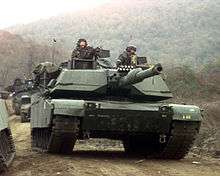
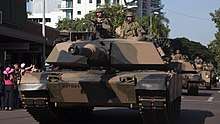
Earlier U.S. military vehicles, used from World War I through the Vietnam War, used a scheme of "olive drab", often with large white stars. Prototypes, early production M1 (105 mm gun) and M1-IP models switched to a flat forest green paint scheme. The large white insignia stars have also transitioned to much smaller black markings. Some units painted their M1s with the older Mobility Equipment Research and Design Command (MERDC) 4-color paint scheme but the turn-in requirements for these tanks required repainting them to overall forest green. Therefore, even though a large number of the base model M1s were camouflaged in the field, few or none exist today.
M1A1s came from the factory with the NATO three color camouflage Black/Med-Green/Dark-Brown Chemical Agent Resistant Coating (CARC) paint jobs. Today M1A1s are given the NATO three color paint job during rebuilds. M1s and M1A1s deployed to Operation Desert Storm were hastily painted desert tan. Some, but not all, of these tanks were re-painted to their "authorized" paint scheme. M1A2s built for Middle Eastern countries were painted in desert tan. Replacement parts (roadwheels, armor skirt panels, drive sprockets, etc.) are painted olive green, which can sometimes lead to vehicles with a patchwork of green and desert tan parts.
Australian M1A1s were desert tan when delivered but have undergone a transition to the Australian Army vehicle standard 'Disruptive Pattern Camouflage'; a scheme that consists of black, olive drab, and brown.[81][82]
The U.S. Army can equip its Abrams tanks with the Saab Barracuda camouflage system, which provides concealment against visual, infrared, thermal infrared, and broad-band radar detection.[83]
Concealment
The turret is fitted with two six-barreled M250 smoke grenade launchers (USMC M1A1s use an eight-barreled version), with one on each side. When deployed, the grenades airburst, creating a thick smoke that blocks both visual and thermal imaging. The engine is also equipped with a smoke generator that is triggered by the driver. When activated, fuel is sprayed into the hot turbine exhaust, creating the thick smoke. However, due to the change from diesel as a primary fuel to the use of JP-8, this system is disabled on most Abrams tanks today because of a slightly elevated risk of fire damage to the engine compartment.
Armor
In July 1973, representatives from Chrysler and General Motors traveled to the United Kingdom, and were escorted by personnel from the Ballistic Research Laboratory and XM1 Project Manager Major General Robert J. Baer to witness the progress of British developed Chobham armor.[84] They observed the manufacturing processes required for the production of Chobham armor, which was an arrangement of metal plates, ceramic blocks and open space;[31] and saw a proposed design for a new British vehicle utilizing it. HEAT and sabot rounds enter the beginning layers of armor but are unable to penetrate the crew compartment. Ceramics have the ability to absorb a great deal of heat, and can blunt physical blows by cracking and deflecting the force. The remaining hot gasses and metal shrapnel spread out or settle in empty air pockets. Both contractors reevaluated their proposed armor configurations based upon the newly obtained data. This led to major changes in the General Motors XM1. The most prominent of which is the turret front changing from vertical to sloped armor. The Chrysler XM1 on the other hand retained its basic shape although a number of changes were made. The Ballistic Research Laboratory had to develop new armor combinations in order to accommodate the changes made by the contractors.[85]
Similar to most other main battle tanks, the M1 Abrams feature composite armor only on the frontal aspect of the hull. However, the Abrams' turret features composite armoring across both the front and the sides. In addition, the side skirts of the frontal half of the hull are also made of composite, providing superior ballistic protection against chemical energy munitions such as HEAT rounds. The composition of the Abrams' composite armor consists of sandwiched plates of non-explosive reactive armor (NERA) between conventional steel plates. The NERA plates feature elasticity, allowing them to flex and distort upon perforation, disrupting the penetrating jets of shaped charges and providing more material and space for a kinetic round to pass through, thus providing increased protection compared to conventional steel armor of similar weight.
For the base model M1 Abrams, Steven J. Zaloga gives a frontal armor estimate of 350 mm vs armor-piercing fin-stabilized discarding-sabot (APFSDS) and 700 mm vs high-explosive anti-tank warhead (HEAT) in M1 Abrams Main Battle Tank 1982–1992 (1993).[86] In M1 Abrams vs T-72 Ural (2009), he uses Soviet estimates of 470 mm vs APFSDS and 650 mm vs HEAT for the base model Abrams. He also gives the Soviet estimates for the M1A1, 600 mm vs APFSDS, and 700 mm vs HEAT.[87]
Armor protection was improved by implementing a new special armor incorporating depleted uranium and other undisclosed materials and layouts.[31] This was introduced into the M1A1 production starting October 1988. This new armor increased effective armor particularly against kinetic energy rounds[88] but at the expense of adding considerable weight to the tank, as depleted uranium is 1.7 times more dense than lead.[89] The first M1A1 tanks to receive this upgrade were tanks stationed in Germany. US-based tank battalions participating in Operation Desert Storm received an emergency program to upgrade their tanks with depleted uranium armor immediately before the onset of the campaign. M1A2 tanks uniformly incorporate depleted uranium armor, and all M1A1 tanks in active service have been upgraded to this standard as well.[90] This variant was designated as the M1A1HA (HA for Heavy Armor).[91] The M1A1 AIM, M1A2 SEP and all subsequent Abrams models feature depleted uranium in both the hull and turret armor.[92] Each Abrams variant after the M1A1 have been equipped with depleted uranium armor of different generations. The M1A1HA uses 1st generation armor, while the M1A2 and M1A1HC use 2nd generation depleted uranium. The M1A2 SEP variants have been equipped with third generation depleted uranium armor combined with a graphite coating. The M1A2C also features increased physical line-of-sight turret armor.[93]
For the M1A1HA, Zaloga gives a frontal armor estimate of 600 mm vs APFSDS and 1300 mm vs HEAT in M1 Abrams Main Battle Tank 1982–1992, nearly double the original protection of the Abrams.[91] In M1 Abrams vs T-72 Ural, he uses different estimates of 600 mm vs APFSDS and 700 mm vs HEAT for the front hull and 800 mm vs APFSDS and 1300 mm vs HEAT for the front of the turret.[87] The protection of M1A2 SEP is a frontal turret armor estimate of 940–960 mm vs APFSDS and 1,320–1,620 vs HEAT, glacis estimate of 560–590 mm vs APFSDS and 510–1,050 vs HEAT, and lower front hull estimate of 580–650 mm vs APFSDS and 800–970 vs HEAT[94]
In 1998, a program was begun to incorporate improved turret side armor into the M1A2. This was intended to offer better protection against rocket-propelled grenades more modern than the baseline RPG-7. These kits were installed on about 325 older M1A2 tanks in 2001-2009 and it was also included in upgraded tanks.[95]
The Abrams may also be fitted with explosive reactive armor over the track skirts if needed (such as the Tank Urban Survival Kit)[96] and slat armor over the rear of the tank and rear fuel cells to protect against ATGMs. Protection against spalling is provided by a kevlar liner.
Damage control
The tank has a halon firefighting system to automatically extinguish fires in the crew compartment. The engine compartment has a firefighting system that is engaged by pulling a T-handle located on the left side of the hull. The Halon gas can be dangerous to the crew.[97] However, the toxicity of Halon 1301 gas at 7% concentration is much less than the combustion products produced by fire in the crew compartment, and CO2 dump would be lethal to the crew. The crew compartment also contains small hand-held fire extinguishers. Fuel and ammunition are stored in armored compartments with blowout panels to protect the crew from the risk of the tank's own ammunition cooking off (exploding) if the tank is damaged—the main gun's ammunition is stored in the rear section of the turret, with blast doors that open under power by sliding sideways only to remove a round for firing, then automatically close. Doctrine mandates that the ammunition door must be closed before arming the main gun.[98]
Tank Urban Survival Kit
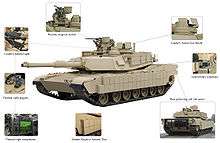
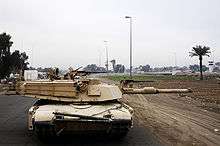
The Tank Urban Survival Kit (TUSK) is a series of improvements to the M1 Abrams intended to improve fighting ability in urban environments.[99][96] Historically, urban and other close battlefields have been poor places for tanks to fight. A tank's front armor is much stronger than that on the sides, top, or rear. In an urban environment, attacks can come from any direction, and attackers can get close enough to reliably hit weak points in the tank's armor or gain sufficient elevation to hit the top armor.
Armor upgrades include reactive armor on the sides of the tank and slat armor (similar to that on the Stryker) on the rear to protect against rocket-propelled grenades and other shaped charge warheads. A Transparent Armor Gun Shield and a thermal sight system are added to the loader's top-mounted M240B 7.62 mm machine gun, and a Kongsberg Gruppen Remote Weapon Turret carrying a 12.7 mm (.50 in) caliber machine gun (again similar to that used on the Stryker) is in place of the tank commander's original 12.7 mm (.50 in) caliber machine gun mount, wherein the commander had to expose himself to fire the weapon manually. An exterior telephone allows supporting infantry to communicate with the tank commander.
The TUSK system is a field-installable kit that allows tanks to be upgraded without needing to be recalled to a maintenance depot. While the reactive armor may not be needed in most situations, like those present in maneuver warfare, items like the rear slat armor, loader's gun shield, infantry phone (which saw use on Marine Corps M1A1s as early as 2003), and Kongsberg Remote Weapons Station for the 12.7 mm (.50 in) caliber machine gun will be added to the entire M1A2 fleet over time.
On 29 August 2006, General Dynamics Land Systems received a U.S. Army order for 505 Tank Urban Survivability Kits (TUSK) for Abrams main battle tanks supporting operations in Iraq, under a US$45 million contract. Deliveries were expected to be completed by April 2009.[100] Under a separate order, the U.S. Army awarded General Dynamics Armament and Technical Products (GDATP) US$30 million to produce reactive armor kits to equip M1A2s. The reactive tiles for the M1 will be locally produced at GDATP's Burlington Technology Center. Tiles will be produced at the company's reactive armor facility in Stone County Operations, McHenry, Mississippi. On 8 December 2006, the U.S. Army added Counter Improvised Explosive Device enhancements to the M1A1 and M1A2 TUSK, awarding GDLS $11.3 million contract, part of the $59 million package mentioned above. In December, GDLS also received an order, amounting to around 40% of a US$48 million order, for loader's thermal weapon sights being part of the TUSK system improvements for the M1A1 and M1A2 Abrams Tanks.[100]
Active Protection System (APS)
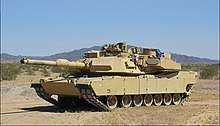
In addition to the armor, some USMC Abrams tanks are equipped with a Softkill Active protection system, the AN/VLQ-6 Missile Countermeasure Device (MCD) that can impede the function of guidance systems of some semi-active control line-of-sight (SACLOS) wire- and radio guided anti-tank missiles (such as the Russian 9K114 Shturm) and infrared homing missiles.[101] The MCD works by emitting a massive, condensed infrared signal to confuse the infrared homing seeker of an anti-tank guided missile (ATGM). However, the drawback to the system is that the ATGM is not destroyed, it is merely directed away from its intended target, leaving the missile to detonate elsewhere. This device is mounted on the turret roof in front of the loader's hatch, and can lead some people to mistake Abrams tanks fitted with these devices for the M1A2 version, since the Commander's Independent Thermal Viewer on the latter is mounted in the same place, though the MCD is box-shaped and fixed in place as opposed to cylindrical and rotating like the CITV.
In 2016, the U.S. Army and Marine Corps began testing out the Israeli Trophy active protection system to protect their Abrams tanks from modern RPG and ATGM threats by either jamming (with ATGMs) or firing small rounds to deflect incoming projectiles.[102] The Army plans to field a brigade of over 80 tanks equipped with Trophy to Europe in 2020.[103] It is planned for up to 261 Abrams to be upgraded with the system, enough for four brigades.[104][105] In June 2018, the Army awarded Leonardo DRS, U.S. partner to Trophy's designer Rafael, a $193 million contract to deliver the system in support of M1 Abrams "immediate operational requirements."[106] U.S. Army M1A2 SEP V2 Abrams tanks deployed to Germany in July 2020 fitted with Trophy systems.[107]
Armament
Primary
M68A1 rifled gun
The main armament of the original model M1 and M1IP was the M68A1 105 mm rifled tank gun firing a variety of armor-piercing fin-stabilized discarding sabot, high explosive anti-tank, high explosive, white phosphorus rounds and an anti-personnel (multiple flechette) round. This gun used a license-made tube of the British Royal Ordnance L7 gun together with the vertical sliding breech block and other parts of the U.S. T254E2 prototype gun. However, it proved to be inadequate; a cannon with lethality beyond the 1.9-mile (3 km) range was needed to combat newer armor technologies. To attain that lethality, the projectile diameter needed to be increased. The tank was able to carry 55 105 mm rounds, with 44 stored in the turret blow-out compartment and the rest in hull stowage.
M256 smoothbore gun
.jpg)
The main armament of the M1A1 and M1A2 is the M256A1 120 mm smoothbore gun, designed by Rheinmetall AG of Germany, manufactured under license in the U.S. by Watervliet Arsenal, New York. The M256A1 is a variant of the Rheinmetall 120 mm L/44 gun carried on the German Leopard 2 on all variants up to the Leopard 2A5. Leopard 2A6 replaced the L/44 barrel with a longer L/55. Due to the increased calibre, only 40 or 42 rounds are able to be stored depending on if the tank is an A1 or A2 model.
The M256A1 fires a variety of rounds. The primary APFSDS round of the Abrams is the depleted uranium M829 round, of which four variants have been designed. M829A1, known as the "Silver Bullet", saw widespread service in the Gulf War, where it proved itself against Iraqi armor such as the T-72. The M829A2 APFSDS round was developed specifically as an immediate solution to address the improved protection of a Russian T-72, T-80U or T-90 main battle tank equipped with Kontakt-5 explosive reactive armor (ERA) as previous rounds were found to be incapable of defeating such armor.[108] Later, the M829A3 round was introduced to improve its effectiveness against next generation ERA equipped tanks, through usage of a multi-material penetrator and increased penetrator diameter that can resist the shear effect of K-5 type ERA. As a counter to that, the Russian army introduced Relikt, the most modern Russian ERA, which is claimed to be twice as effective as Kontakt-5.[109] Development of the M829 series is continuing with the M829A4 currently entering production, featuring advanced technology such as data-link capability.[110] The Abrams also fires high-explosive anti-tank warhead shaped charge rounds such as the M830, the latest version of which (M830A1) incorporates a sophisticated multi-mode electronic sensing fuse and more fragmentation that allows it to be used effectively against armored vehicles, personnel, and low-flying aircraft. The Abrams uses a manual loader. The fourth tank crew member on the Abrams also provides additional support for maintenance, observation post/listening post (OP/LP) operations, and other tasks.
The new M1028 120 mm anti-personnel canister cartridge was brought into service early for use in the aftermath of the 2003 invasion of Iraq. It contains 1,098 3⁄8-inch (9.5 mm) tungsten balls that spread from the muzzle to produce a shotgun effect lethal out to 600 meters (2,000 ft). The tungsten balls can be used to clear enemy dismounts, break up hasty ambush sites in urban areas, clear defiles, stop infantry attacks and counter-attacks and support friendly infantry assaults by providing covering fire. The canister round is also a highly effective breaching round and can level cinder block walls and knock man-sized holes in reinforced concrete walls for infantry raids at distances up to 75 meters (246 ft).[111] Also in use is the M908 obstacle-reduction round. It is designed to destroy obstacles and barriers. The round is a modified M830A1 with the front fuse replaced by a steel nose to penetrate into the obstacle before detonation.[112]
The U.S. Army Research Laboratory (ARL) conducted a thermal analysis of the M256 from 2002 to 2003 to evaluate the potential of using a hybrid barrel system that would allow for multiple weapon systems such as the XM1111 Mid- Range munition, airburst rounds, or XM 1147. The test concluded that mesh density (number of elements per unit area) impacts accuracy of the M256 and specific densities would be needed for each weapon system.[113]
The Army is developing a new round to replace the M830/M830A1, M1028, and M908. Called the Advanced Multi-Purpose (AMP) round, it will have point detonation, delay, and airburst modes through an ammunition data-link and a multi-mode, programmable fuse in a single munition. Having one round that does the job of four would simplify logistics and be able to be used on a variety of targets. The AMP is to be effective against bunkers, infantry, light armor, and obstacles out to 500 meters, and will be able to breach reinforced concrete walls and defeat ATGM teams from 500 to 2,000 meters.[114][115] Orbital ATK was awarded a contract to begin the first phase of development for the AMP XM1147 High Explosive Multi-Purpose with Tracer cartridge in October 2015.[116]
In addition to these, the XM1111 (Mid-Range-Munition Chemical Energy) was also in development. The XM1111 was a guided munition using a dual-mode seeker that combined imaging-infrared and semi-active laser guidance. The MRM-CE was selected over the competing MRM-KE, which used a rocket-assisted kinetic energy penetrator. The CE variant was chosen due to its better effects against secondary targets, providing a more versatile weapon. The Army hoped to achieve IOC with the XM1111 by 2013.[117] However, the Mid-Range Munition was cancelled in 2009 along with Future Combat Systems.[118]
Secondary
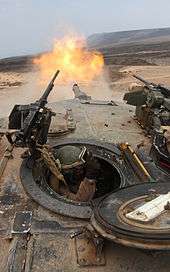
The Abrams tank has three machine guns, with an optional fourth:
- A .50 cal. (12.7 mm) M2HB machine gun in front of the commander's hatch. On the M1 and M1A1, this gun is mounted on the Commander's Weapons Station. This allows the weapon to be aimed and fired from within the tank. The later M1A2 variant had a 'flex' mount that required the tank commander to expose his or her upper torso in order to fire the weapon. In urban environments in Iraq, this was found to be unsafe. With the Common Remote Operated Weapons System (CROWS) add-on kit, an M2A1 .50 Caliber Machine gun, M240, or M249 SAW can be mounted on a CROWS remote weapons platform (similar to the Protector M151 remote weapon station used on the Stryker family of vehicles). Current variants of the Tank Urban Survival Kit (TUSK) on the M1A2 have forgone this, instead adding transparent gun shields to the commander's weapon station. The upgrade variant called the M1A1 Abrams Integrated Management (AIM) equips the .50 caliber gun with a thermal sight for accurate night and other low-visibility shooting.[119]
- A 7.62 mm M240 machine gun in front of the loader's hatch on a skate mount (seen at right). Some of these were fitted with gun shields during the Iraq War, as well as night-vision scopes for low-visibility engagements and firing.
- A second 7.62 mm M240 machine gun in a coaxial mount (i.e., it points at the same targets as the main gun) to the right of the main gun. The coaxial MG is aimed and fired with the same computerized firing control system used for the main gun.
- (Optional) A second coaxial .50 cal. (12.7 mm) M2HB machine gun can be mounted directly above the main gun in a remote weapons platform as part of the TUSK upgrade kit.
Aiming
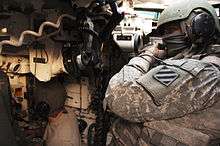
The Abrams is equipped with a ballistic fire-control computer that uses user and system-supplied data from a variety of sources to compute, display, and incorporate the three components of a ballistic solution—lead angle, ammunition type, and range to the target—to accurately fire the main gun. These three components are determined using a laser rangefinder, crosswind sensor, a pendulum static cant sensor, data concerning performance and flight characteristics of each specific type of round, tank-specific boresight alignment data, ammunition temperature, air temperature, barometric pressure, a muzzle reference system (MRS) that determines and compensates for barrel drop at the muzzle due to gravitational pull and barrel heating due to firing or sunlight, and target speed determined by tracking rate tachometers in the Gunner's or Commander's Controls Handles. All of these factors are computed into a ballistic solution and updated 30 times per second. The updated solution is displayed in the Gunner's or Tank Commander's field of view in the form of a reticle in both day and Thermal modes. The ballistic computer manipulates the turret and a complex arrangement of mirrors so that all one has to do is keep the reticle on the target and fire to achieve a hit. Proper lead and gun tube elevation are applied to the turret by the computer, greatly simplifying the job of the gunner.
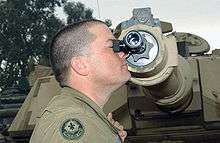
The fire-control system uses this data to compute a firing solution for the gunner. The ballistic solution generated ensures a hit percentage greater than 95 percent at nominal ranges. Either the commander or gunner can fire the main gun. Additionally, the Commander's Independent Thermal Viewer (CITV) on the M1A2 can be used to locate targets and pass them on for the gunner to engage while the commander scans for new targets. In the event of a malfunction or damage to the primary sight system, the main and coaxial weapons can be manually aimed using a telescopic scope boresighted to the main gun known as the Gunner's Auxiliary Sight (GAS). The GAS has two interchangeable reticles; one for High-explosive anti-tank warhead and MPAT (MultiPurpose AntiTank) rounds and one for APFSDS and STAFF (Smart Target-Activated Fire and Forget) ammunition. Turret traverse and main gun elevation can be accomplished with manual handles and cranks in the event of a Fire Control System or Hydraulic System failure. The commander's M2HB .50 caliber machine gun on the M1 and M1A1 is aimed by a 3× magnification sight incorporated into the Commander's Weapon Station (CWS), while the M1A2 uses either the machine gun's own iron sights, or a remote aiming system such as the CROWS system when used as part of the TUSK (Tank Urban Survival Kit). The loader's M240 machine gun is aimed either with the built-in iron sights or with a thermal scope mounted on the machine gun.
In late 2017, the 400 USMC M1A1 Abrams will be upgraded with better and longer-range sights on the Abrams integrated display and targeting system (AIDATS) replacing the black-and-white camera view with a color one and adding day/night thermal sights, simplified handling with a single set of controls, and a slew to cue button that repositions the turret with a single command. Preliminary testing showed the upgrades reduced target engagement time from six seconds to three by allowing the commander and gunner to work more closely and collaborate better on target acquisition.[120][121]
Mobility
Tactical
The M1 Abrams's powertrain consists of a Honeywell AGT 1500 (originally made by Lycoming) multifuel gas turbine capable of 1,500 shaft horsepower (1,100 kW) at 3,000 rpm and 3,950 lb⋅ft (5,360 N⋅m) at 1,000 rpm, and a six-speed (four forward, two reverse) Allison X-1100-3B Hydro-Kinetic automatic transmission, giving it a governed top speed of 45 mph (72 km/h) on paved roads, and 30 mph (48 km/h) cross-country. With the engine governor removed, speeds of around 60 mph (97 km/h) are possible on an improved surface; however, damage to the drivetrain (especially to the tracks) and an increased risk of injuries to the crew can occur at speeds above 45 mph (72 km/h). The tank was built around this engine[122] and it is multifuel–capable, including diesel, kerosene, any grade of motor gasoline, and jet fuel (such as JP-4 or JP-8). For logistical reasons, JP-8 is the U.S. military's universal fuel powering both aircraft and vehicle fleets. On the other hand, Australian M1A1 AIM SA burn diesel fuel, since the use of JP-8 is less common in the Australian Army.
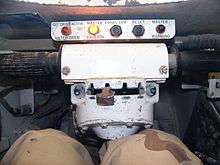
The gas turbine propulsion system has proven quite reliable in practice and combat, but its high fuel consumption is a serious logistic issue (starting up the turbine alone consumes nearly 10 US gallons (38 L) of fuel).[123] The engine burns more than 1.67 US gallons (6.3 L) per mile (60 US gallons (230 L) per hour) when traveling cross-country and 10 US gallons (38 L) per hour when idle.[8] The high speed, high temperature jet blast emitted from the rear of M1 Abrams tanks makes it hazardous for infantry to take cover or follow behind the tank in urban combat.[124] The turbine is very quiet when compared to diesel engines of similar power output and produces a significantly different sound from a contemporary diesel tank engine, reducing the audible distance of the sound, thus earning the Abrams the nickname "whispering death" during its first Reforger exercise.
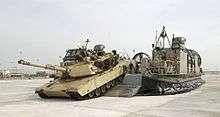
Honeywell was developing another gas turbine engine with General Electric for the XM2001 Crusader program that was to be a replacement for the Abrams's AGT-1500 engine.[125] The new LV100-5 engine was lighter and smaller (43% fewer parts) with rapid acceleration, quieter running, and no visible exhaust.[126] It also featured a 33% reduction in fuel consumption (50% less when idle) and near drop-in replacement.[127] The Abrams-Crusader Common Engine Program was shelved when the Crusader program was canceled, however Phase 2 of Army's PROSE (Partnership for Reduced O&S Costs, Engine) program called for further development of the LV100-5 and replacement of the current AGT-1500 engine.[128]
General Dynamics has been working on a drop-in diesel engine to replace the gas turbine engine. It is smaller than the turbine, 14% cheaper to operate per mile, and has a four-fan cooling system that is to greatly reduce the tank's heat signature.[129] General Dynamics is offering the Tognum America/12V883 diesel engine with new Diehl 570P3 tracks. The engine represents advancements in diesel engine design since the Abrams was first designed, including a common rail fuel injector system where fuel is pressurized and atomized in the cylinder rather than mechanically sprayed. It also has greater torque, an altered nuclear, biological, and chemical protection system that operates independently of the engine, uses less fuel while idle, is quieter, and gives off significantly less heat and pollutants. Incorporating the diesel engine into the Abrams would decrease the operating cost of an armored brigade combat team by 14 percent per mile, increase its operating range from 205 miles to 300+ miles, and use half the amount of fuel on a combat day than the turbine engine. The tracks are a version of the Leopard 2's tracks with different rubber pads and a larger center guide. The improved engine and tracks are not part of an Army upgrade program, but may be included in a near-term engineering change proposal (ECP) phase.[130][131]
Using a high power density 330 cc (20 in3) Wankel rotary engine modified to use diesel and military grade jet fuel, the Army's TARDEC developed a 220-pound (100 kg) Auxiliary Power Unit designed to fit into the M1 Abrams, replacing an existing battery pack that weighs about 500 pounds (230 kg). The new APU will also be more fuel efficient than the tank's main engine.[132] Testing of the first APUs began in 2009.
_Tank_Platoon_BLT_1-1_stationed_at_Twentynine_Palms%2C_Calif.%2C_directs_an_M1-A1_Abrams_tank_during_a_training_exercise.jpg)
Although the M1 tank is not designed to carry riders easily, provisions exist for the Abrams to transport troops in tank desant with the turret stabilization device switched off. A battle equipped infantry squad may ride on the rear of the tank, behind the turret. The soldiers can use ropes and equipment straps to provide handholds and snap links to secure themselves. If and when enemy contact is made, the tank conceals itself allowing the infantry to dismount.[133]
Strategic
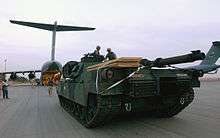
Strategic mobility is the ability of the tanks of an armed force to arrive in a timely, cost effective, and synchronized fashion. The Abrams can be carried by a C-5 Galaxy or a C-17 Globemaster III. The limited capacity (two combat-ready tanks in a C-5, one combat-ready tank in a C-17) caused serious logistical problems when deploying the tanks for the first Persian Gulf War, though there was enough time for 1,848 tanks to be transported by ship.
Marines transport their Marine Air Ground Task Force (MAGTF)-attached Abrams tanks by combat ship. A Wasp-class Landing Helicopter Dock (LHD) typically carries a platoon of 4 to 5 tanks attached to the deployed Marine Expeditionary Unit, which are then amphibiously transported to shore by Landing Craft Air Cushion (LCAC) at 1 combat-ready tank per landing craft.
The Abrams is also transportable by truck, namely the Oshkosh M1070 and M1000 Heavy Equipment Transporter System (HETS). The HETS can operate on highways, secondary roads, and cross-country. It accommodates the four tank crew members.[134]
The first instance of the Abrams being airlifted directly into a battlefield occurred in October 1993. Following the Battle of Mogadishu, 18 M1 tanks were airlifted by C-5 aircraft to Somalia from Hunter Army Airfield, Georgia.[135][136]
Variants and upgrades
- XM1-FSED: Preproduction test model. Eleven Full-Scale Engineering Development test bed vehicles were produced in 1977–78. These vehicles were also called Pilot Vehicles and numbered PV-1 through PV-11.
- M1: First production variant. Production began (at Chrysler) in 1979 and continued to 1985 (at General Dynamics) (3,273 built for the US). The first 110 tanks were Low Rate Initial Production (LRIP) models, still called XM1s, because they were built prior to the tank being type-classified as the M1.
- M1IP (Improved Performance): Produced briefly in 1984 before the M1A1, contained upgrades and reconfigurations like new turret with thicker frontal armor, new turret is referred as "long" turret instead of older "short" turret, armor upgraded from ~650mm line of sight thickness to ~880mm (894 built for US).
- M1A1:[nb 1] Production started in 1985 and continued to 1992, pressurized NBC system, rear bustle rack for improved stowage of supplies and crew belongings, redesigned blow-off panels and M256 120 mm smoothbore cannon (4,976 built for the U.S. Army, 221 for USMC, 59 M1A1 AIM SA sold to Australia).
- M1A1HA (Heavy Armor): Added 1st generation depleted uranium armor components. Some tanks were later upgraded with 2nd generation depleted uranium armor components, and are unofficially designated M1A1HA+.
- M1A1HC (Heavy Common): Added new 2nd generation depleted uranium armor components, digital engine control and other small upgrades common between Army and Marine Corps tanks.
- M1A1D (Digital): A digital upgrade for the M1A1HC, to keep up with M1A2 SEP, manufactured in quantity for only 2 battalions.
- M1A1 AIM v.1 (Abrams Integrated Management): A program whereby older units are reconditioned to zero hour conditions;[137] and the tank is improved by adding Forward-Looking Infra-Red (FLIR) and Far Target Locate sensors, a tank-infantry phone, communications gear, including FBCB2 and Blue Force Tracking to aid in crew situational awareness, and a thermal sight for the .50 caliber machine gun.[119]
- M1A1 AIM v.2/M1A1 SA (Situational Awareness): Upgrades similar to AIM v.1 tanks + new 3rd generation depleted uranium armor components. Configuration for the Royal Moroccan Army, which is almost identical to the Australian variant, except exportable turret armor is installed by General Dynamics Land System to replace the DU armor.[138]
- M1A1 FEP (Firepower Enhancement Package): Similar upgrade to AIM v.2 for USMC tanks.
- M1A1KVT (Krasnovian Variant Tank): M1A1s that have been visually modified to resemble Soviet-made tanks for use at the National Training Center, fitted with MILES gear and a Hoffman device.
- M1A1M: An export variant ordered by the Iraqi Army with depleted uranium armor removed and older thermal imaging system with lower resolution used.[139]
- M1A1 (AIDATS upgrade): Upgrade-only variant to all USMC General Dynamics M1A1 Abrams tanks to improve the tank commander's situational awareness with an upgraded thermal sight, color day camera, and a stationary color display.
- M1A2 (Baseline): Production began in 1986 and entered service in 1992[140] (77 built for the U.S. and more than 600 M1s upgraded to M1A2, 315 for Saudi Arabia, 1,005 for Egypt, 218 for Kuwait). The M1A2 offers the tank commander an independent thermal sight and ability to, in rapid sequence, shoot at two targets without the need to acquire each one sequentially, also 2nd generation depleted uranium armor components.[141]
- M1A2 SEP (System Enhancement Package): Has upgraded third-generation depleted uranium armor components with graphite coating (240 new built, 300 M1A2s upgraded to M1A2 SEP for the US, also unknown numbers of upgraded basic M1s and M1IPs, also 400 oldest M1A1s upgraded to M1A2 SEP).
- M1A2S (Saudi Package): Saudi Arabian variant upgrade of the M1A2 based on M1A2 SEP, with some features, such as depleted uranium armor, believed to be missing and replaced by special armor. (442 M1A2s upgraded to M1A2S).[142][143]
- M1A2 SEPv2: Added Common Remotely Operated Weapon Station as standard, color displays, improved interfaces, a new operating system, improved front and side armor with ERA (TUSK kit), tank-infantry phone as standard, and an upgraded transmission for better durability.[144]
- M1A2C (SEPv3): Has increased power generation and distribution, better communications and networking, new Vehicle Health Management System (VHMS) and Line Replaceable Modules (LRMs) for improved maintenance, an Ammunition DataLink (ADL) to use airburst rounds, improved counter-IED armor package, improved FLIR using long- and mid-wave infrared, a low-profile CROWS RWS, Next Generation Armor Package (NGAP),[145] and an Auxiliary Power Unit (APU) under armor to run electronics while stationary instead of the engine, visually distinguishing the version by a small exhaust at the left rear. More passive ballistic protection added to the turret faces, along with new Explosive Reactive Armor mountings (Abrams Reactive Armor Tile (ARAT))[146] and Trophy Active Protection systems added to the turret sides. Prototypes began testing in 2015,[147][144][148] and the first were delivered in October 2017.[149] The first unit received them in July 2020.[150]
- M1A2T: Special configuration variant of the M1A2C reportedly being offered for sale to Taiwan as of March 2019 and approved by US State Department as of July 2019.[151] Per DSCA statement, it is roughly equivalent to M1A2C, except depleted uranium armor is replaced by FMS export armor. There is no mention of the Trophy APS system. The new-built tanks will be produced at Anniston Army Depot, Anniston, Alabama, and the Joint Systems Manufacturing Center, Lima, Ohio.[152][153][154]
- M1A2D (SEPv4): Under engineering development with delivery planned to start by 2021.[155] The Commander's Primary Sight, also known as the Commander's Independent Thermal Viewer, and Gunner's Primary Sight will be upgraded with 3rd Gen FLIR, an improved laser rangefinder and color cameras. Additional improvements will include advanced meteorological sensors, laser warning/detection receivers, directional smoke grenade launchers and integration of the new XM1147 multi-purpose (AMP) 120mm tank round.[156][157][158][159][160] The AN/VVR-4 laser warning receiver and ROSY rapid obscurant system have been trialed by the US Army for adoption on the Abrams tank and Bradley fighting vehicle.[161][162][163]
- M1A2-K: Under development, unique variant for the Kuwaiti Army, slated to replace Kuwait's current M1A2 fleet.[164]
- M1A3: Under research development as of 2014.[40][10] Improvements are to include a lighter 120 mm gun, added road wheels with improved suspension, a more durable track, lighter-weight armor, long-range precision armaments, and infrared camera and laser detectors. The variant is believed to have a new diesel engine, instead of the gas turbine engine used in previous M1 variants.[165]
- M1 TTB (Tank Test Bed): Prototype with unmanned turret, 3 crew members in armored capsule in front of the heavy armored hull, main armament was 120 mm smoothbore gun, M256 derivative or modification, mechanical loading system under turret, never fielded.
- CATTB: The Component Advanced Technology Test Bed was an experimental model with a lightweight 120 mm smoothbore cannon,[166] heavy armored turret and upgraded hull based on the M1 chassis. It had a mechanical loading system in turret bustle, a new engine and probably other upgrades, never fielded. The tank went into trials in 1987–88.[167]
- M1 Thumper: Experimental variant by Lockheed Martin, equipped with the 140 mm XM291 ATACS smoothbore cannon. Similar to the CATTB, it included a larger, elongated turret to offer protection levels comparable to the M1A2 while allowing the mounting of the larger cannon and its longer ammunition. Cancelled with the end of the Cold War, and never fielded.
- M1 AGDS (Air Ground Defense System): Proposed air defence variant of the Abrams equipped with dual 35 mm Bushmaster III autocannons, 12 ADATS missiles and advanced electro-optical and radar targeting systems derived from the ADATS. It was supposed to be capable of both air defence and anti-tank purposes with the ADATS MIM-146 missiles which was a dual purpose ATGM/SAM. The proposal never saw consideration and was never developed further.[168]
Specialized
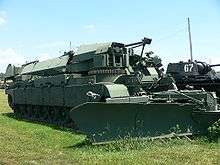
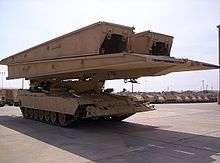
- M1 Grizzly Combat Mobility Vehicle (CMV).[169][170]
- M1 Panther II: A remote controlled mine clearing vehicle with turret removed, mine rollers on front, and the Standardized Teleoperation System.[171]
- M104 Wolverine Heavy Assault Bridge[172]
- M1074 Joint Assault Bridge (JAB): Bridgelayer combining a heavy "scissor" bridge with the M1 Abrams chassis. Expected to reach low-rate initial production in 2019 to replace the M60 AVLB and M104 Wolverine.[173]
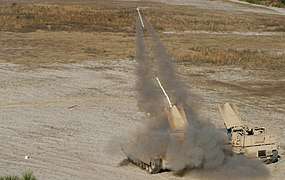
- M1150 Assault Breacher Vehicle (ABV): Assault variant for the USMC. Based upon the M1A1 Abrams chassis, the Assault Breacher Vehicle has a variety of systems installed, such as a full-width mine plow, two linear demolition charges, and a lane-marking system. Reactive armor has been fitted to the vehicle providing additional protection against High-explosive anti-tank warhead-based weapons. The turret has been replaced by a new smaller one with two MICLIC launchers at its rear. A M2HB .50 machine gun in a remote weapons station is mounted on the commander's cupola and a bank of grenade launchers are fitted to each side of the superstructure to cover the frontal arc for self-protection.[174][175]
- M1 Armored Recovery Vehicle: Only a prototype produced.
Specifications[176][177]
| M1 | M1IP | M1A1 | M1A2 | M1A2 SEP | |
|---|---|---|---|---|---|
| Produced | 1979–85 | 1984 | 1985–92 | 1992 on | 1999 on |
| Length | 32.04 ft (9.77 m) | ||||
| Width | 12 ft (3.7 m) | ||||
| Height | 7.79 ft (2.37 m) | 8.0 ft (2.4 m) | |||
| Top speed | 45 mph (72 km/h) | 41.5 mph (66.8 km/h) | 42 mph (68 km/h) | ||
| Range | 310 mi (500 km) | 275 mi (443 km) | 288 mi (463 km) | 265 mi (426 km) | 264 mi (425 km) |
| Power | 1,500 shp (1,100 kW) | ||||
| Weight | 61.4 short tons (55.7 t) | 62.8 short tons (57.0 t) | M1A1: 61.5 short tons (55.8 t)M1A1 SA: 67.6 short tons (61.3 t) | 68.4 short tons (62.1 t) | SEP v1: 69.5 short tons (63.0 t) SEP v2: 71.2 short tons (64.6 t)
M1A2C (SEP v3): 73.6 short tons (66.8 t) |
| Main armament | 105 mm M68A1 rifled | 120 mm M256A1 smoothbore | |||
| Crew | 4 (commander, gunner, loader, driver) | ||||
| Protection | Chobham armor | Longer turret for thicker composite array | M1A1: BRL-2 composite armor M1A1HA/HC/M1A2: Depleted uranium inserts in frontal turret arrays M1A1 AIM/SA: Depleted uranium inserts in hull and turret |
Depleted uranium inserts in hull and turret
Improved Chobham armor and increased turret armor | |
Operators
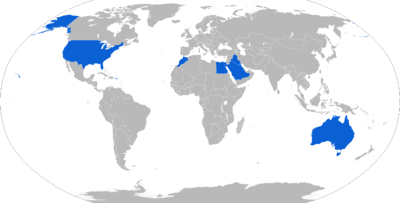
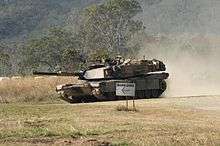
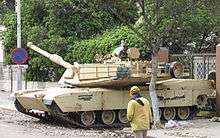
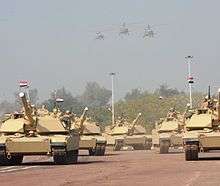
.svg.png)






Potential operators




See also
Main Battle Tanks of comparable role, performance, and era
- Al-Khalid tank
- Ariete
- Arjun
- Challenger 2
- Leclerc
- K2 Black Panther
- Leopard 2 & 2E
- Merkava
- Oplot-M
- T-72, T-80 & T-90
- Type 90 & Type 10
- Type 96 & Type 99
References
Footnotes
- During early development in the late 1970s it was referred to as the XM-1E.
Citations
- John Pike. "Lima Army Tank Plant (LATP)". Globalsecurity.org. Archived from the original on 25 September 2010. Retrieved 30 June 2010.
- "Department of Defense – Annual Report FY99". Archived from the original on 3 November 2013. Retrieved 20 February 2014.
- "M1A2 Abrams". Archived from the original on 13 December 2017. Retrieved 12 December 2017.
- Hunnicutt, R.P. (1990). Abrams: A History of the American Main Battle Tank. Presidio. p. 202. ISBN 9780891413882.
- "ASAALT Weapon Systems Handbook 2018" (PDF). Office of the Assistant Secretary of the Army (Acquisition, Logistics and Technology). Archived (PDF) from the original on 19 October 2018. Retrieved 19 October 2018.
- "Abrams Tank Fact File for the United States Army". United States Army. Archived from the original on 15 November 2013. Retrieved 16 November 2015.
- Foss, Chris (2005). Jane's Armour and Artillery 2005–2006. Jane's Information Group. p. 162. ISBN 0-7106-2686-X.
- Pike, John E. "M1 Abrams Main Battle Tank". GlobalSecurity.org. Archived from the original on 25 October 2015. Retrieved 16 November 2015.
- M1 Abrams Main Battle tank Archived 21 August 2010 at the Wayback Machine. FAS.org, 14 April 2000.
- Osborn, Kris (26 September 2009). "Army looking into lighter Abrams tank". Army Times. Archived from the original on 21 July 2012. Retrieved 31 December 2013.
- Majumdar, Dave (2 June 2016), "Inside the US Army's Lethal New M1A2 SEP v.3 Abrams Main Battle Tank", The National Interest, archived from the original on 18 October 2017, retrieved 18 October 2017
- "Licht vom Mond". Der Spiegel (in German). Archived from the original on 22 October 2012. Retrieved 8 November 2010.
- Weaver Jr., Warren (9 August 1969). "Tank Fund Halted for a Cost Study". The New York Times. Archived from the original on 26 August 2018. Retrieved 26 August 2018.
- John Pike (13 May 2010). "MBT-70 / XM803". Globalsecurity.org. Archived from the original on 23 August 2010. Retrieved 30 June 2010.
- Hunnicutt 2015.
- "The First Chrysler Bail-Out: The M-1 Tank". Washington Monthly. 1987.
- https://www.pica.army.mil/Picatinny/(X(1)S(jnp3njocqw3j4rrsh5iyrqn2))/products_services/products12.aspx?AspxAutoDetectCookieSupport=1
- Hunnicutt, R.P. (1990). Abrams: A History of the American Main Battle Tank. Presidio. p. 312. ISBN 9780891413882. 105mm Gun Tank M1 and IPM1 in a combination mount with M68A1 Gun
- Osprey Publishing, New Vanguard #2: M1 Abrams Main Battle Tank 1982-1992, Steve Zaloga & Peter Sarson
- "M900 105mm APFSDS-T".
- "Picatinny Arsenal - The Joint Center of Excellence for Guns and Ammunition". Pica.army.mil. Retrieved 11 April 2020.
- Ogorkiewicz, Richard M. (1991). Technology of Tanks (Vols 1-2). London: Janes Information Group. p. 82.
- http://archive.org/details/DTIC_ADA051050
- CANNON, 105MM GUN: M68A1E2 MIL-C-45504A Rev. D Jan 1987 | Military and Government Specs & Standards (Naval Publications and Form Center) (NPFC)
- Hunnicutt, R.P. (1990). Abrams: A History of the American Main Battle Tank. Presidio. p. 234. ISBN 9780891413882. "The gun tube was extended by 1.5 feet compared to the M68E1."
- Hunnicutt, R.P. (1990). Abrams: A History of the American Main Battle Tank. Presidio. p. 312. ISBN 9780891413882. 105mm Gun Tank M1 and IPM1 in a combination mount (M68A1 Gun)
- Direct Support, General Support, and Depot Maintenance Manual for Cannon, 105-MM Gun, M68 & M68E1, M116 and 140 Mount TM 9-1000-213-35 by Fred C. (Chief of Staff) Weyand | Jan 1, 1978
- "General Dynamics buys Chrysler tank division". New York Times, 20 February 1982. Archived from the original on 3 April 2017. Retrieved 3 April 2017.
- History of the U.S. Army Research Laboratory. 2017.
- "How M1 Tanks Work". HowStuffWorks. 7 May 2002. Archived from the original on 18 April 2018. Retrieved 3 April 2018.
- Pike, John. "Lima Army Tank Plant (LATP)". Globalsecurity.org. Archived from the original on 3 March 2014. Retrieved 20 February 2014.
- "The Army's M1 Tank: Has It Lived Up To Expectations?". Project on Government Oversight. 1 January 1990. Archived 17 November 2012 at the Wayback Machine
- Zaloga & Sarson 1993, p. 24
- GAO/NSIAD-92-94, "Operation Desert Storm: Early performance assessment of Bradleys and Abrams" Archived 14 June 2007 at the Wayback Machine, p. 24. GAO, January 1992. Quote: "... 23 Abrams tanks were destroyed or damaged in the Persian Gulf area. Of the nine Abrams destroyed, seven were due to friendly fire, and two were intentionally destroyed to prevent capture after they became disabled. Other Abrams tanks were damaged by enemy fire, land mines, on-board fires, or to prevent capture after they became disabled."
- Wyden, Ron (January 1992). "OPERATION DESERT STORM: Early Performance Assessment of Bradley and Abrams" (PDF). Government Accountability Office. Archived from the original (PDF) on 11 April 2019. Retrieved 5 July 2018.
- "A Company, 3–66 Armor, Abrams (Bumper # A-33)". TAB H – Friendly-fire Incidents. Archived from the original on 1 June 2013.
At approximately 4:30 AM on 27 February, an anti-tank guided missile (probably fired from a Bradley) struck A-33 in the engine compartment. The crew, uninjured, was evacuating the disabled tank when two DU rounds hit the tank in the left side of the hull and exited through the right side. The tank commander, driver, and gunner sustained injuries from fragments. The loader, who was already outside the tank, was uninjured. A-31 crew members assisted in rescuing A-33's crew.
; Sketch depicting the path of a DU 120 mm round through the hull of Abrams C-12 Archived 27 June 2009 at the Wayback Machine. OSD. - Diaz, R. Gary. "Intervehicular Information System (IVIS): The Basis for a Tactical Information System", SAE Paper Number: 940982, General Dynamics, 1 March 1994.
- "Archived copy" (PDF). Archived (PDF) from the original on 5 May 2015. Retrieved 4 April 2015.CS1 maint: archived copy as title (link)
- "Army Equipment Program" (PDF). U.S. Army. May 2014. Archived from the original (PDF) on 9 April 2015.
- Biddle, Stephen."On Operation Iraqi Freedom: Outside Perspectives", Statement Before The Committee On Armed Services, United States House Of Representatives, First Session, 108th Congress, 21 October 2003
- Komarow, Steven. "Tanks take a beating in Iraq" Archived 18 March 2012 at the Wayback Machine. USA Today, 29 March 2005.
- Greem, Michael. M1 Abrams at War 2005. Zenith Press. p. 99. ISBN 0-7603-2153-1. Archived from the original on 20 September 2017.
- "Najaf fighting 'heaviest so far'". 26 March 2003. Archived from the original on 25 November 2016. Retrieved 23 May 2020 – via news.bbc.co.uk.
- "ArtOfWar. Понамарчук Евгений. Потери танков "Абрамс" в Иракской войне". artofwar.ru. Retrieved 23 May 2020.
- Conroy, Jason & Martz, Ron. Heavy Metal: A Tank Company's Battle To Baghdad. Potomac Books, 2005, p. 158.
- Zucchino, David: Thunder Run: The Armored Strike to Capture Baghdad. Grove Press, 2004, pp. 20–30, 73.
- "Technical Intelligence Bulletins". Wlhoward.com. May–June 2003. Archived from the original on 12 March 2007.
- Conway, John P. (7 January 2004). "Abrams Tank Systems: Lessons Learned Operation Iraqi Freedom" (PDF). Archived (PDF) from the original on 5 September 2006.
- "U.S. Army Battling To Save Equipment". Washington Post. Archived from the original on 6 October 2014. Retrieved 11 October 2014.
- "PROTECTOR Remote Weapon Station". Kongsberg Protech Systems. Archived from the original on 5 October 2013. Retrieved 4 October 2013.
- Komarow, Steven. "Tanks adapted for urban fights they once avoided" Archived 22 August 2011 at the Wayback Machine. USA Today, 29 March 2005.
- Michael R. Gordon (21 May 2008). "Operation in Sadr City Is an Iraqi Success, So Far". The New York Times. Archived from the original on 23 June 2017.
- "Super RPG threat, Army passes on system that could defeat RPG-29, DoD officials say". ArmyTimes. Archived from the original on 19 July 2012.
- Binnie, Jeremy (20 June 2014), Iraqi Abrams losses revealed, Janes, archived from the original on 2 May 2015
- Michael Pregent; Michael Weiss (12 August 2014). "Exploiting the ISIS Vulnerabilities in Iraq". Wall Street Journal. Archived from the original on 10 December 2015. Retrieved 8 December 2015.
Yet ISIS does not have the highly trained maintenance crews that are necessary to keep these weapons in good working order.
- Agency Backs More Abrams for Iraq in ISIS Fight Archived 23 December 2014 at the Wayback Machine – DoDBuzz.com, 22 December 2014
- "Hezbollah Brigades hurries troops to Mosul fight | FDD's Long War Journal". www.longwarjournal.org. Archived from the original on 5 August 2017. Retrieved 23 May 2020.
- The 'Beast of Hit,' Abrams Tank Plays Role in Iraqi Fight against ISIS Archived 17 April 2016 at the Wayback Machine – Military.com, 13 April 2016
- "Rudaw – Iraqi army, Shiite militia and Peshmerga exchange heavy fire north of Kirkuk". Archived from the original on 20 October 2017. Retrieved 20 October 2017.
- Marine tanks prepare for their first missions in Afghanistan. U.S. Marine Corps, 18 January 2011. Archived 16 October 2014 at the Wayback Machine
- U.S. Tanks En Route to Southwestern Afghanistan Archived 30 May 2011 at the Wayback Machine. American Forces Press Service, 19 November 2010. Retrieved 12 March 2011.
- Vosman, Dylan (14 May 2015). "Saudi M1A2 Abrams MBTs deployed near Yemen border". Defence Blog: Military and Defence News. Archived from the original on 25 September 2015.
- Saudi Losses in Yemen War Exposed by US Tank Deal Archived 11 August 2016 at the Wayback Machine – Defenseone.com, 9 August 2016
- "Kingdom of Saudi Arabia – M1A2S Saudi Abrams Main Battle Tanks and M88Al/A2 Heavy Equipment Recovery Combat Utility Lift Evacuation System (HERCULES) Armored Recovery Vehicles (ARV)". Defense Security Cooperation Agency. 9 August 2016. Archived from the original on 13 September 2016. Retrieved 19 September 2016.
- "Saudi Losses in Yemen War Exposed by US Tank Deal". Archived from the original on 10 August 2016. Retrieved 10 August 2016.
- Ewing, Philip (21 April 2011). "The tank at the end of history". DoD Buzz. Military.com. Archived from the original on 25 April 2011. Retrieved 23 April 2011.
- "Support Abrams". General Dynamic Land Systems. Archived from the original on 10 April 2011. Retrieved 23 April 2011. Cite journal requires
|journal=(help) - "Lighter, Yet Deadlier". Gannett Government Media Corporation. Archived from the original on 10 January 2013. Retrieved 24 July 2011. Cite journal requires
|journal=(help) - "Over Army Objections, Industry and Congress Partner to Keep Abrams Tank Production 'Hot'". National Defense Magazine, October 2013.
- New $120 million upgrade program for the U.S. M1 Abrams main battle tank – Armyrecognition.com, 12 December 2014
- Congress Again Buys Abrams Tanks the Army Doesn't Want Archived 24 December 2014 at the Wayback Machine – Military.com, 18 December 2014
- Asia-Pacific Defence Reporter, Volume 30. Asia-Pacific Defence Publications. 2004. Retrieved 2 April 2011.
- Wasserbly, Daniel (14 October 2014). "AUSA 2014: Army outlines upcoming combat vehicle choices". IHS Jane's International Defence Review. Archived from the original on 29 April 2015.
ECP1A for Abrams, which just completed a 'critical design review', and includes design efforts to incorporate data links for future ammunition, increased protection, as well as on-board diagnostics and a shift from line replaceable units (LRUs) to line replaceable modules (LRMs). LRMs are easier to replace because there are fewer cables, boxes, and cards to handle.
- "Army Evaluated Nine Vehicles Against GCV in Analysis of Alternatives". Inside Washington Publisher. January 2010. Archived from the original on 28 September 2010. Retrieved 12 January 2011.
- Paul McLeary (25 February 2011). "Abrams is Model for Army Infantry Carrier". The McGraw-Hill Companies, Inc. Retrieved 25 February 2011.
- "General Dynamics Land Systems M1/M1A1/M1A2 Abrams MBT (United States), MBTs and medium tanks". Jane's Armour and Artillery. Jane's Information Group. Archived from the original on 11 August 2011. Retrieved 1 July 2011.
- "New Army tank could mean changes for M1A1 fleet". Marine Corps Times. 30 September 2009. Archived from the original on 10 September 2012. Retrieved 31 December 2013.
- Osborn, Kris (1 March 2017). "Army Plans New Tank After Abrams – 2030s". Archived from the original on 23 March 2017.
- Osborn, Kris (13 January 2017). "The U.S. Army Has Big Plans for a New Super Tank (Lasers Included)". The National Interest. Archived from the original on 28 September 2018. Retrieved 12 November 2018.
- Miller, Jason. "Australian Military Vehicles Research -Disruptive Pattern Camouflage for the Australian Abrams M1A1 AIM SA (as at 2010)". Mheaust.com.au. Archived from the original on 6 July 2011. Retrieved 28 June 2011.
- Australian Government, Department of Defence (13 May 2010). "Exercise Chong Ju – Desert tan vs Auscam Abrams". Defence.gov.au. Archived from the original on 29 July 2012. Retrieved 28 June 2011.
- U.S. Army Orders Saab Barracuda Camouflage Solutions Archived 15 June 2015 at the Wayback Machine – Armyrecognition.com, 12 June 2015
- Hunnicutt, R.P. (1990). Abrams: A History of the American MBT. Presidio. p. 177.
- Hunnicutt, R.P. (1990). Abrams: A History of the American MBT. Presidio. p. 178.
- Zaloga & Sarson 1993, pp. 9–10: Zaloga gives another set of figures in this book 350mm against APFSDS and 700mm vs HEAT.
- Zaloga 2009, p. 15: Author mentions that a Soviet report estimated the protection of the basic M1 to be equivalent to 470 mm steel armor against armor-piercing rounds and equivalent to 650 mm steel armor against shaped charge warheads.
- Hunnicutt, R.P. (1990). Abrams: A History of the American MBT. Presidio. p. 245.
- "BBC: US to use depleted uranium". BBC News. 18 March 2003. Archived from the original on 19 May 2009. Retrieved 9 June 2009.
- Clancy, Tom: Armored Cav: A Guided Tour of an Armored Cavalry Regiment. Berkeley Books, 1994, p. 58.
- Zaloga & Sarson 1993, p. 11
- "The Army's Future Combat Systems Program and Alternatives" (PDF). Congressional Budget Office Study: 67. August 2006.
- "Here's your first look at the Army's new M1 Abrams variant". Task & Purpose. 26 February 2019. Retrieved 6 June 2019.
- Prado, Fabio. "Main Battle Tank – M1, M1A1, and M1A2 Abrams". www.fprado.com. Archived from the original on 22 November 2016. Retrieved 5 March 2017.
- Steven J. Zaloga (21 March 2019). M1A2 Abrams Main Battle Tank 1993-2018. New Vanguard. p. 48. ISBN 978-1472831781.
- "Archived copy". Archived from the original on 15 May 2013. Retrieved 22 July 2017.CS1 maint: archived copy as title (link)
- "NIOSH Pocket Guide to Chemical Hazards". CDC. Archived from the original on 18 August 2017.
- The_Chieftain (14 October 2018), Chieftain Chats Abrams, retrieved 21 February 2019
- Cramer, Eric W. "TUSK to Update Abrams for Urban Battle". Defense AT&L: July–August 2005.
- "Tank Urban Survivability Kit (TUSK)". Archived from the original on 13 October 2014. Retrieved 11 October 2014.
- "Defense Update.com". Defense Update.com. 25 April 2006. Archived from the original on 10 March 2009. Retrieved 9 June 2009.
- Walsh: Marines May Protect Tanks With Active and EW Protection Systems, Much Like Ship Self-Defense Archived 14 April 2016 at the Wayback Machine – News.USNI.org, 14 April 2016
- Some Abrams Tanks Will Have 'Trophy' System By 2020: Army Archived 11 October 2017 at the Wayback Machine – Military.com, 9 October 2017
- 261 M1 Abrams tanks to receive Rafael’s Trophy Active Protection System Archived 15 February 2018 at the Wayback Machine – Armyrecognition.com, 14 February 2018
- All Armored Brigades To Get Active Protection Systems: Gen. Milley Archived 15 July 2018 at the Wayback Machine. Breaking Defense. 15 May 2018.
- Abrams tanks get new round of Israeli-made ‘shields’ to fend off anti-tank weapons. Army Times. 6 July 2018.
- US Army deploys in Germany M1A2 Sep V2 main battle tanks fitted with Trophy APS Active Protection System. Army Recognition. 18 July 2020.
- Fabio Prado. "Main Battle Tank – M1, M1A1, and M1A2 Abrams". Fprado.com. Archived from the original on 11 July 2011. Retrieved 28 June 2011.
- "Internet Archive Wayback Machine". 24 February 2008. Archived from the original on 24 February 2008. Retrieved 28 June 2011.
- "Next-Gen 120 mm Tank Killer: ATK's M829E4 AKE". Defense Industry Daily. Archived from the original on 16 July 2011.
- Hilmes (2004), p. 79.
- "M908 HE-OR-T" Archived 12 November 2014 at the Wayback Machine. ATK.com
- South, Joseph; Carter, Robert (August 2005). "Thermal Analysis of an M256 120-mm Cannon". Army Research Laboratory. doi:10.21236/ada437279.
- "Archived copy" (PDF). Archived from the original (PDF) on 14 November 2012. Retrieved 7 January 2013.CS1 maint: archived copy as title (link)
- Army developing new 120 mm AMP tank round Archived 7 April 2014 at the Wayback Machine – Army.mil, 19 March 2014
- Orbital ATK Awarded $16 Million to Develop Next Generation 120mm Tank Ammo Archived 12 October 2015 at the Wayback Machine – Businesswire.com, 8 October 2015
- "Clank Softly and Carry a Better Shillelagh". Defense Industry Daily. Archived from the original on 7 June 2011.
- "MRM cancelled" Archived 9 November 2011 at the Wayback Machine. Soldiergeek.com, 11 July 2011.
- "General Dynamics Awarded $34 Million for M1A1 Abrams Tank Upgrades" (Press release). General Dynamics. 5 September 2008. Archived from the original on 3 January 2010.
- Abrams Tank Upgrades Will Give Marines ‘Killer Edge’ Archived 24 August 2016 at the Wayback Machine – DoDBuzz.com, 23 August 2016
- Marines' M1A1 tanks: How an upgrade will help make them more lethal Archived 27 August 2016 at the Wayback Machine – MarineCorpstimes.com, 26 August 2016
- "Heavy duty: overhaul under way for Abrams tank engine". Accessmylibrary.com. 1 September 2006. Archived from the original on 11 January 2009. Retrieved 9 June 2009.
- Fabio Prado. "Main Battle Tank – M1, M1A1, and M1A2 Abrams". 64.26.50.215. Archived from the original on 29 September 2007. Retrieved 9 June 2009.
- "FM 3-06-11, Chapter 7, section C-1". United States military. Archived from the original on 4 January 2012.
The extreme heat produced immediately to the rear of the M1-series tanks prevents dismounted infantry from following closely...
- "GE Press Release: GE and Honeywell Begin Testing of LV100-5 Engine For Abrams-Crusader Common Engine Program". Geae.com. 27 August 2001. Archived from the original on 28 September 2010. Retrieved 9 June 2009.
- "GE – Aviation: LV100". Archived from the original on 7 June 2008. Retrieved 7 August 2008.CS1 maint: BOT: original-url status unknown (link)
- "GE – Aviation: LV100 Advantages". Archived from the original on 18 June 2008. Retrieved 7 August 2008.CS1 maint: BOT: original-url status unknown (link)
- "AIM Program's M1A1 Tank Refits and Rebuilds Continue". Defenseindustrydaily.com. 2 May 2005. Archived from the original on 14 July 2009. Retrieved 9 June 2009.
- "Diesel M1 engine" Archived 4 September 2015 at the Wayback Machine. Nationaldefensemagazine.com, January 2013. Retrieved: 17 December 2012.
- Abrams Dieselization Project: A Modest Proposal Archived 10 November 2013 at the Wayback Machine – Defensemedianetwork.com, 5 November 2013
- Abrams Dieselization Project: Doing the Math Archived 10 November 2013 at the Wayback Machine – Defensemedianetwork.com, 7 November 2013
- "TARDEC Auxiliary Power Unit for a tank". Engineeringtv.com. Archived from the original on 21 June 2009. Retrieved 9 June 2009.
- Department of the Army (2009). "7". U.S. Army Warrior Ethos And Combat Skills Handbook (Field Manual No. 3‑21.75). Morris Book Publishing, LLC. ISBN 978-1-59921-819-9. Archived from the original on 20 July 2011. Retrieved 2 June 2010.
- "M1070 Heavy Equipment Transporter (HET) Fact File United States Army". Army.mil. Archived from the original on 6 July 2010. Retrieved 30 June 2010.
- Haulman, Daniel L. "THE UNITED STATES AIR FORCE IN SOMALIA, 1992–1995" (PDF). Archived (PDF) from the original on 28 September 2017. Retrieved 28 September 2017.
- Leland, John W. "THE CHRONOLOGICAL HISTORY OF THE C-5 GALAXY" (PDF). ?. Archived (PDF) from the original on 10 October 2017. Retrieved 29 September 2017.
- "M1 Abrams Main Battle Tank". Fas.org. Archived from the original on 21 August 2010. Retrieved 30 June 2010.
- "Archived copy". Archived from the original on 14 May 2019. Retrieved 14 May 2019.CS1 maint: archived copy as title (link) CS1 maint: BOT: original-url status unknown (link)
- "Armor: Iraq Getting M-1A1 Tanks". Strategypage.com. 3 August 2008. Archived from the original on 16 April 2009. Retrieved 9 June 2009.
- "M1A1/2 Abrams Main Battle Tank". Army Technology. Archived from the original on 6 April 2016. Retrieved 14 April 2016.
- M1 Abrams Main Battle Tank Archived 21 August 2010 at the Wayback Machine. Federation of American Scientists
- Tyler Rogoway. "Houthi Rebels Destroy M1 Abrams Tanks With Basic Iranian Guided Missiles". Foxtrot Alpha. Archived from the original on 9 September 2017. Retrieved 14 April 2016.
- "Saudi Arabia Orders 69 More M1A2S Abrams Heavy Tanks". Archived from the original on 3 March 2016. Retrieved 14 April 2016.
- Administrator. "M1A2 Abrams SEP V3 main battle tank technical data sheet specifications pictures video 11710154 – United States army heavy armoured vehicles tank UK – United States US Army Military equipment UK". Archived from the original on 1 April 2016. Retrieved 14 April 2016.
- Trevithick, Joseph. "Picture Of Newest M1 Abrams Tank Variant With Previously Unseen Turret Armor Emerges". The Drive. Retrieved 23 May 2020.
- Trevithick, Joseph. "U.S. Army M1 Abrams Tanks in Europe Are Getting Explosive Armor". The Drive. Retrieved 23 May 2020.
- General Dynamics Land Systems displays M1A2 SEPV3 most advanced digital main battle tank Archived 14 October 2015 at the Wayback Machine – Armyrecognition.com, 12 October 2015
- Army Upgrades M1A2 Abrams Battle Tank Archived 11 October 2016 at the Wayback Machine – Scout.com/Military.com, 3 June 2016
- Army rolls out latest version of iconic Abrams Main Battle Tank Archived 9 October 2017 at the Wayback Machine – Army.mil, 9 October 2017
- Greywolf Brigade of 1st U.S. Cavalry Division first to receive new M1A2C Abrams tanks. Army Recognition. 22 July 2020.
- https://www.nytimes.com/reuters/2019/07/08/world/asia/08reuters-usa-taiwan.html?searchResultPosition=8
- "Taipei Economic and Cultural Representative Office in the United States (TECRO) – M1A2T Abrams Tanks and Related Equipment and Support | The Official Home of the Defense Security Cooperation Agency". www.dsca.mil. Retrieved 23 May 2020.
- "Taiwan seeks to procure M1A2X main battle tank from US". Defence Blog. 19 March 2019. Archived from the original on 19 March 2019. Retrieved 19 March 2019.
- Drillsma, Ryan (19 March 2019). "US could announce sale of M1A2X tanks to Taiwan before July". Taiwan News. Taipei. Archived from the original on 19 March 2019. Retrieved 19 March 2019.
- "Archived copy". Archived from the original on 22 May 2019. Retrieved 24 May 2019.CS1 maint: archived copy as title (link)
- Dean, Glenn. "2017 NDIA Armaments Systems Forum" (PDF). National Defense Industrial Association. Archived (PDF) from the original on 21 July 2018. Retrieved 23 July 2018.
- "US engineering big upgrades for M1A2 SEP v4 Abrams tanks starting in 2021 to match Russian Armata and other new tanks - NextBigFuture.com". 17 November 2016. Archived from the original on 15 March 2018. Retrieved 15 March 2018.
- Villasanta, Arthur Dominic (28 March 2017). "New US Army M1 Abrams Tank Rounds can Easily Destroy the T-14 Armata". Archived from the original on 15 March 2018. Retrieved 15 March 2018.
- Administrator. "U.S. Army will begin the development of M1A2 Abrams SEP V4 main battle tank 11302171 – February 2017 Global Defense Security army news industry – Defense Security global news industry army 2017 – Archive News year". www.armyrecognition.com. Archived from the original on 15 March 2018. Retrieved 15 March 2018.
- tmgdadmin (5 September 2017). "General Dynamics Receives Contracts to Upgrade Abrams Main Battle Tanks". Archived from the original on 15 March 2018. Retrieved 15 March 2018.
- "UTC Aerospace readies AN/VVR-4 laser warning system". Jane's 360. Archived from the original on 23 July 2018. Retrieved 23 July 2018.
- "Laser warning goes modular". Jane's 360. Archived from the original on 23 July 2018. Retrieved 23 July 2018.
- "Rheinmetall ROSY at US Army Expeditionary Warrior Experiments 2018". Youtube. Rheinmetall Defence. Retrieved 23 July 2018.
- Binnie, Jeremy (20 December 2017). "Kuwait to get 'unique' Abrams tank variant". IHS Jane's 360. Archived from the original on 26 December 2017. Retrieved 26 December 2017.
- "M1A3" Archived 16 December 2016 at the Wayback Machine. Global Security.org
- Khourdaji, Samir (May 1990). "RD & E Centre Technical Report No. 13492 "FINITE STRESS ANALYSIS FOR COMPONENT ADVANCED TECHNOLOGY TEST BED (CATTB)". Defense Technical Information Center. Defense Technical Information Center. Retrieved 16 July 2016.
- "CATTB data". Archived from the original on 30 September 2011. Retrieved 28 June 2011.
- Sharoni, Asher H.; Bacon, Lawrence (July–August 1996). "Forward Area Air-Ground Defense". Armor. 105 (4): 15–20 – via Google Books.
- John Pike. "Grizzly [Breacher]". Globalsecurity.org. Archived from the original on 6 July 2010. Retrieved 30 June 2010.
- "Defense & Security Intelligence & Analysis: IHS Jane's – IHS". wayback.archive-it.org. Retrieved 30 March 2009.
- John Pike. "Panther". Globalsecurity.org. Archived from the original on 9 June 2010. Retrieved 30 June 2010.
- John Pike. "Wolverine (Heavy Assault Bridge)". Globalsecurity.org. Archived from the original on 16 July 2010. Retrieved 30 June 2010.
- Army, DRS Set To Integrate New Bridging System on Tanks – Defensenews.com, 6 September 2016
- "ABV Assault Breacher Vehicle engineer armoured vehicle tank". Archived from the original on 6 February 2010. Retrieved 5 February 2010.
- Abramson, Mark, "ABVs ready to break Afghan ground", Stars and Stripes, 1 February 2010.
- "ABRAMS TANK UPGRADE". US Army Acquisition Support Centre. 2019.
- www.armyrecognition.com https://www.armyrecognition.com/united_states_army_heavy_armoured_vehicles_tank_uk/m1a2_sep_main_battle_tank_technical_data_sheet_specifications_pictures_video_11610154.html. Retrieved 12 June 2019. Missing or empty
|title=(help) - "Acquisition of the ABRAMS Main Battle Tank". Australian National Audit Office. 17 July 2007. Archived from the original on 5 June 2011. Retrieved 6 May 2014.
- Abernethy, Mark (7 March 2017). "Army's plans for more and better tanks". Australian Financial Review. Archived from the original on 26 June 2018. Retrieved 20 August 2018.
- Campbell, Angus. "Chief of Army address to the Defence Magazine Conference". Australian Army. Archived from the original on 27 March 2019. Retrieved 17 March 2019.
- IISS 2017, p. 372.
- Archived 11 May 2013 at the Wayback Machine
- "Procurement: Iraq Buys What It Knows". Strategypage.com. 18 December 2008. Archived from the original on 15 April 2009. Retrieved 9 June 2009.
- "Iraqi military plans major arms purchase" Archived 18 July 2011 at the Wayback Machine. Your Defence News, 16 December 2008.
- M1 Abrams Tanks for Iraq Archived 19 September 2008 at the Wayback Machine. Defense Industry Daily, 15 March 2009.
- Agence France-Presse (9 August 2010). "Iraq takes delivery of American tanks". defencetalk.com. Archived from the original on 14 August 2010.
- "Iraqi Army receives last shipment of Abrams tanks" Archived 28 September 2013 at the Wayback Machine. Army.mil, 6 September 2011.
- "6 more tanks" Archived 19 September 2008 at the Wayback Machine. Defenseindustrydaily.com, 5 October 2012.
- Zaloga, Steven (March 2019). M1A2 Abrams Main Battle Tank 1993–2018. New Vanguard 268. Osprey.
- M1 Abrams Archived 13 September 2007 at the Wayback Machine. Militarium.net
- "The 2006 Saudi Shopping Spree: $2.9B to Upgrade M1 Abrams Tank Fleet". DefenseIndustryDaily.com. 4 January 2011. Archived from the original on 25 October 2006. Retrieved 28 July 2011.
- "Saudi Arabia Orders 69 More M1A2S Abrams Heavy Tanks" Archived 3 March 2016 at the Wayback Machine. Deagel.com, 8 January 2013.
- "Morocco Purchases US-Made M1A1 Abrams Tanks". Morocco World News. 30 August 2015. Archived from the original on 3 May 2016. Retrieved 14 April 2016.
- "General Dynamics Awarded $358 Million for 150 M1A1 SA Abrams Tanks for Morocco". generaldynamics.com. 30 September 2015. Archived from the original on 15 April 2016. Retrieved 14 April 2016.
- "بالصور حفل تسلم أولى دبابات "أبرامز" الأمريكية الموجهة للقوات المسلحة الملكية". Medi 1. Archived from the original on 1 August 2016. Retrieved 26 July 2016.
- "Morocco Abrams tank programme moves forward". IHS Janes. Archived from the original on 4 March 2016. Retrieved 14 April 2016.
- Binnie, Jeremy (28 July 2016). "North African rivals receive new tanks". IHS Jane's. Retrieved 29 July 2016.
- "Morocco – Abrams Tank Enhancement, Support, and Equipment | The Official Home of the Defense Security Cooperation Agency". www.dsca.mil. Retrieved 23 May 2020.
- Fabio Prado (10 December 2009). "Main Battle Tank – M1, M1A1, and M1A2 Abrams". Armorsite. Archived from the original on 3 July 2009. Retrieved 9 June 2009.
- Pike, John (16 January 2013). "M1 Abrams Main Battle Tank". Global Security. Archived from the original on 23 October 2017.
- Osborn, Kris (16 October 2017). "First New Army M1A2 SEP v3 Abrams Tank Arrives". Scout. Archived from the original on 10 October 2017.
- "M-1 Abrams 105 mm: tanques estocados nos EUA podem interessar ao Brasil?" (in Portuguese). Retrieved 1 August 2019.
- "Oportunidade: EUA oferecem ao Brasil tanques, jipes e helicópteros" (in Portuguese). Retrieved 1 August 2019.
- "Message to the Congress on Designating Brazil as a Major Non-NATO Ally". White House. 8 May 2019.
- "Trump moves to designate Brazil a 'major non-NATO ally'". RT America. 8 May 2019.
- Ζητήστε μας ό,τι σας χρειάζεται. Kathimerini (in Greek). n.d. Archived from the original on 7 July 2012. Retrieved 9 April 2012.
- Agence France-Presse "Greece Considers Free Tank Offer". Defense News, 7 December 2011. Retrieved: 18 April 2012.
- "Πέντε C 130 και 100 άρματα μάχης Abrams "έρχονται" από ΗΠΑ". onalert.gr. Archived from the original on 12 November 2014. Retrieved 1 April 2015.
- Peru; Future main battle tank projects lags on despite criticism Archived 28 September 2013 at the Wayback Machine. Dmilt.com, 2 September 2013.
- "Abrams tanks still on defense wish list". Taipei Times. 24 May 2015. Archived from the original on 31 December 2016. Retrieved 31 December 2016.
- "MND confirms U.S. M1A1 tank sales to Taiwan under negotiation". Taipei Times. 14 November 2016. Archived from the original on 31 December 2016. Retrieved 31 December 2016.
- Yeo, Mike (6 October 2017). "Giving up on Abrams tank acquisition, Taiwan moves to upgrade its M60A3 tanks".
- "MND confirms U.S. M1A1 tank sales to Taiwan under negotiation". Archived from the original on 12 July 2018. Retrieved 12 July 2018.
- "Taiwan Army mulls spending US$990 million on M1A2 tanks". FOCUS TAIWAN News Channel. 9 July 2018. Archived from the original on 12 July 2018. Retrieved 12 July 2018.
- News, Taiwan. "US State Department greenlights US$2.2 billio..." Taiwan News. Retrieved 23 May 2020.
- Judson, Jen (9 July 2019). "US State Dept. OKs possible $2 billion Abrams tank sale to Taiwan". Defense News. Retrieved 23 May 2020.
Bibliography
- Orr, Kelly. King of the Killing Zone. W.W. Norton Company, 1989.
- Rostker, Bernard (1998). "Environmental Exposure Report: Depleted Uranium in the Persian Gulf (II)". DoD Publication, gulflink.osd.mil. Archived from the original on 3 June 2010. Retrieved 30 June 2010.
- United States General Accounting Office:Operation Desert Storm: Early Performance Assessment of Bradley and Abrams. Washington, January 1992.PDF.
- Halberstadt, Hans. Desert Storm Ground War. Osceola, WI: Motorbooks International, 1991. 128 pp.
- Hilmes, Rolf (1 December 2004). "Arming Future MBTs – Some Considerations". Military Technology. Mönsch.
- Hunnicutt, R.P. Patton: A History of the American Main Battle Tank. Presidio Press, 1984 ISBN 0-89141-230-1.
- Hunnicutt, Richard (2015). Abrams: A History of the American Main Battle Tank. Echo Point Books. ISBN 9781626541665.
- Forty, George: Tank Action. From the Great War to the Persian Gulf, Allan Sutton Publishing Ltd., Phoenix Mill 1995.
- "M1 Abrams Main Battle Tank". FAS Military Analysis Network. Retrieved 17 January 2004.
- "TUSK to update Abrams for urban battle". Army News Service. Archived from the original on 16 March 2005. Retrieved 6 April 2005.
- Army Times – Two soldiers die in attack on Abrams tank, 29 October 2003
- Practical Applications of Vehicle Control within the Distributed Processing Architecture, Proceedings of the 1992 American Control Conference, Ruggirello, Joseph A., Bielawski, Dennis A., and Diaz, R. Gary, General Dynamics, IEEE, Published Jun. 1992
- Zaloga, Steve; Sarson, Peter (1993). M1 Abrams Main Battle Tank 1982–1992. New Vanguard (Book 2). Oxford, UK: Osprey Publishing. ISBN 1-85532-283-8.
- Zaloga, Steven J. (2009). M1 Abrams vs T-72 Ural: Operation Desert Storm 1991. Oxford, UK; New York: Osprey Publishing. ISBN 978-1-84603-407-7. LCCN 2009502059.
External links
| Wikimedia Commons has media related to M1 Abrams. |
- Abrams Tank Fact File for the United States Army
- M1A1 main battle tank on armyrecognition.com
- M1 Abrams page, with a detailed overview of how the tank works on howstuffworks.com
- M1 Tank Urban Survivability Kit (TUSK), M1A1 AIM Upgrade, and M1A2 SEP Upgrade on Defense-Update.com
- M1 Abrams Main Battle Tank page on GlobalSecurity.org
- AGT1500 Turbine Technology on Honeywell.com
- M1 Abrams Tanks for Iraq
- M1A2 on Armour.ws
- M1A1/2 Abrams page on the Armor Site
- Main Battle Tank M1A1 Abrams on Enemyforces.com
- M1 Abrams modernisation 2011
- M1 Abrams modernisation 2012
.jpg)
